January 28
Breakfast, then off to a place near where Hillary lives to see and photograph monks going for alms. A bell/chime heralds their imminent arrival, and they pass by in a couple of minutes., extending their bowls for donations of rice.
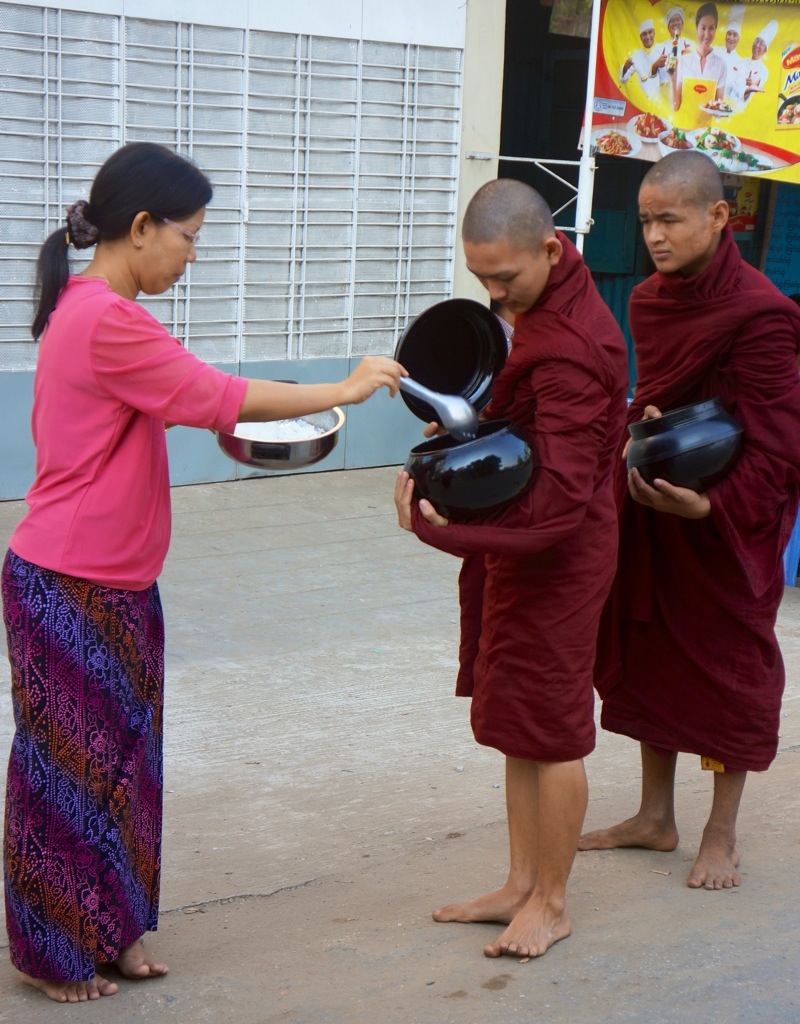
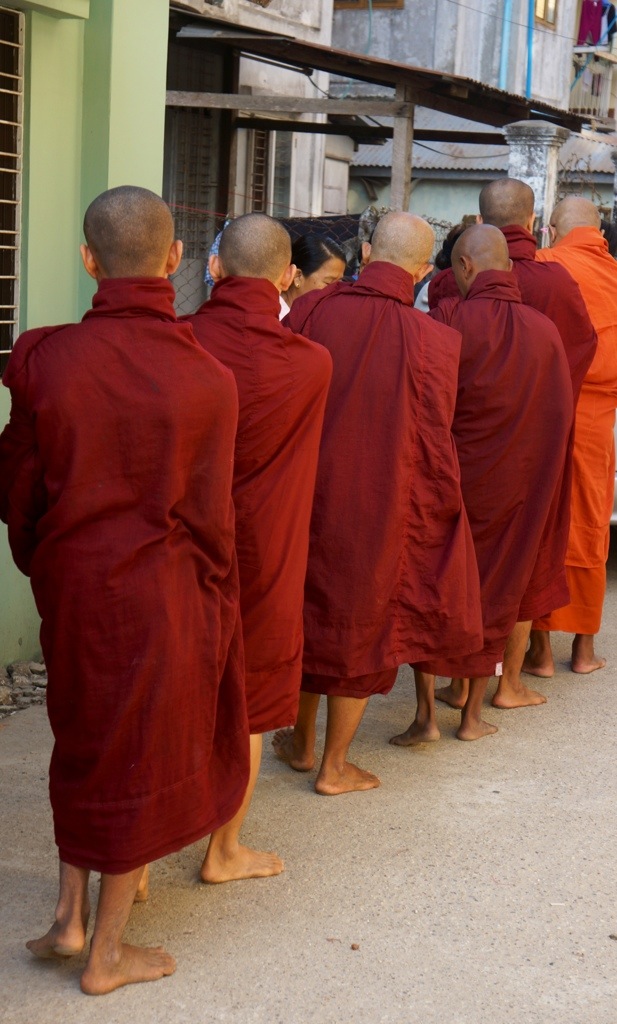
Off to the Golden Valley Art Centre, recommended yesterday by Damon and Stacy. Run by Peter and Vicki, they represent 49 artists, all but a handful of whom are from Myanmar. Included among the artists are a son, daughter-in-law, son-in-law and 10-year old granddaughter of Peter and Vicki’s. They go out with groups of about twenty artists to paint on site in various Myanmar locales, and just yesterday returned from Bagan. We like a lot of the work and also like Peter and Vicki (pictured below). Wind up buying a small still life by the painter who Damon and Stacy have collected some twenty pieces of.
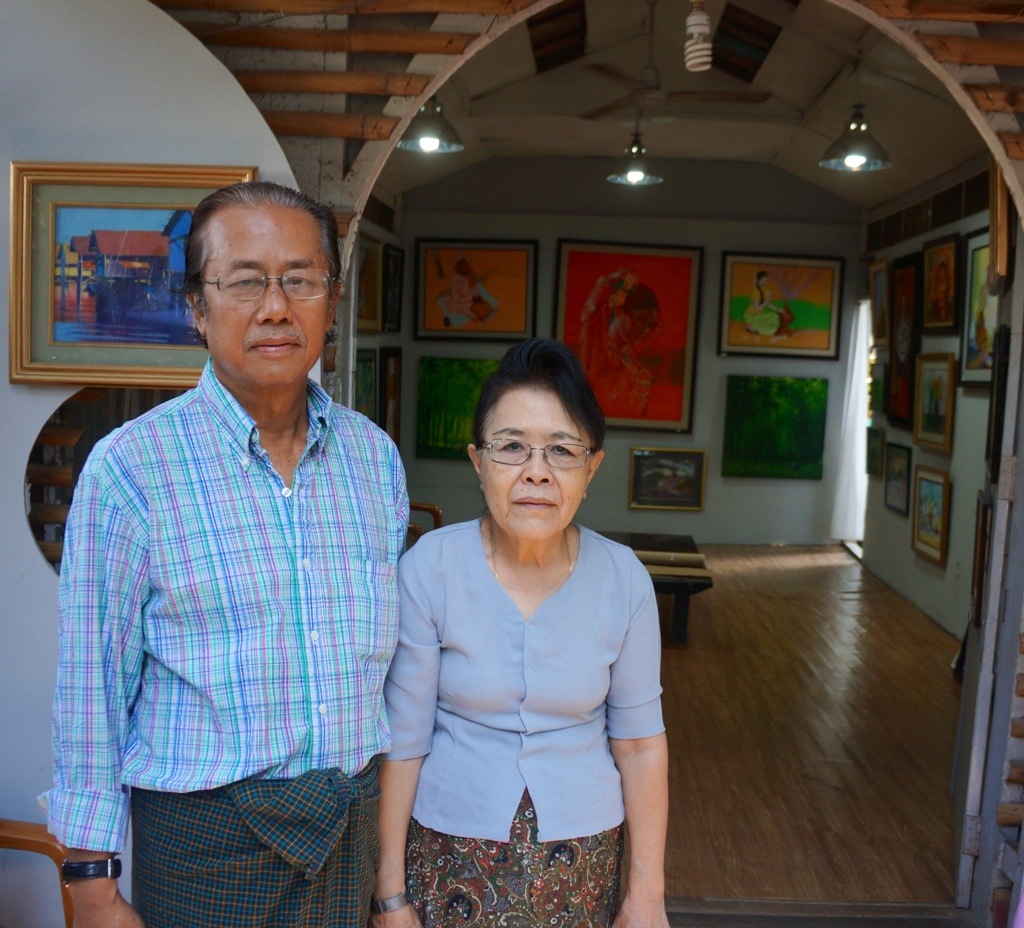
Drive to Yangon University, where Sammy Samuels had informed us there would be a Holocaust Memorial Service. There’s a large turnout, primarily of students, and the program consists of speeches, a poem recital, a Yizkor prayer led by Sammy and a moving short movie about a Polish boy who was raised in an orphanage in Warsaw. Sammy introduces us to various dignitaries, including the Israeli ambassador, the head of the UN in Myanmar and, most helpfully, the young man who is the new cultural affairs person for the US Embassy, Erik V.E. Eisele, who we introduce to Hillary and tell he must get in touch with Dotty. This could prove a very useful contact for Dotty, for Hillary and for Erik. We say goodbye to Sammy, who says we should stay in touch.
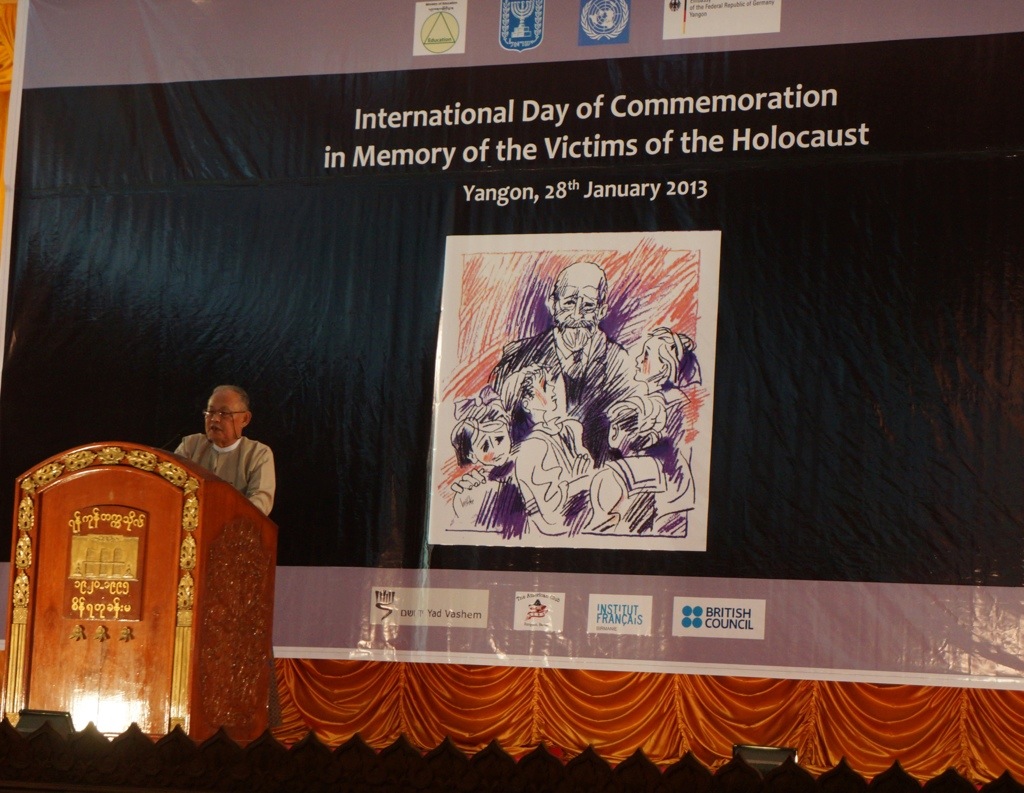
Quick lunch before we visit an NGO called Myanmar Egress, which is engaged on training people in areas such as social entrepreneurship, leadership, mass communication and other related areas. What’s rather amazing is that they were allowed to exist under the military dictatorship. They were closely monitored, though, but now seem to be enjoying newfound opportunities. Among the training they are now doing is English language work for the Myanmar police forces. We meet several of the people involved and look in on a couple classes. To be honest, though, we do not emerge with a very clear notion of what they are about. The program manager with whom we met is to send us an overall description in English.
Back to the hotel for rest and preliminary packing. Return visit to Shwedagon Pagoda for a farewell sunset. This spectacular, spacious pagoda is both an attraction for tourists and an active site of worship for Buddhists. The central spire rises more than 300 feet and is encrusted with nearly 8,000 diamonds, rubies, sapphires, topaz, and capped by a 76-carat diamond. Volunteers clean the floors daily on the day of the week on which they are born. Altars for each day of the week, two for Wednesday, ring the central area. The pagoda is gilted over each year with donations from worshipers. Thiri, our travel agent, joins us and acts as our tour guide. Crowded, but oddly peacefu, Shwedagon is a fitting end to our stay in Myanmar.
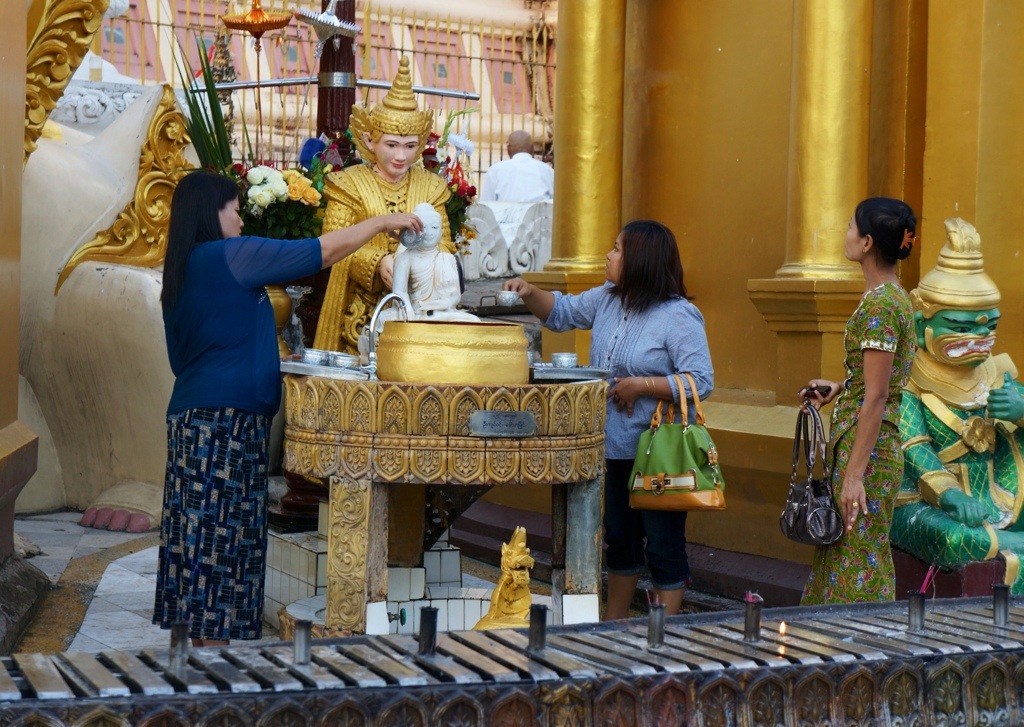
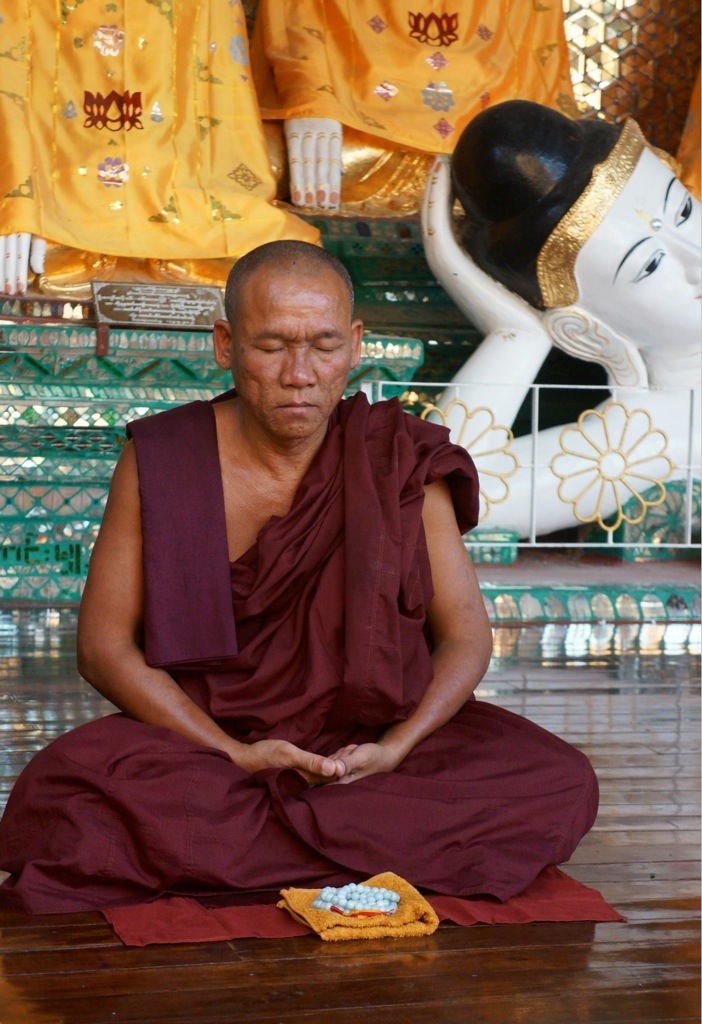

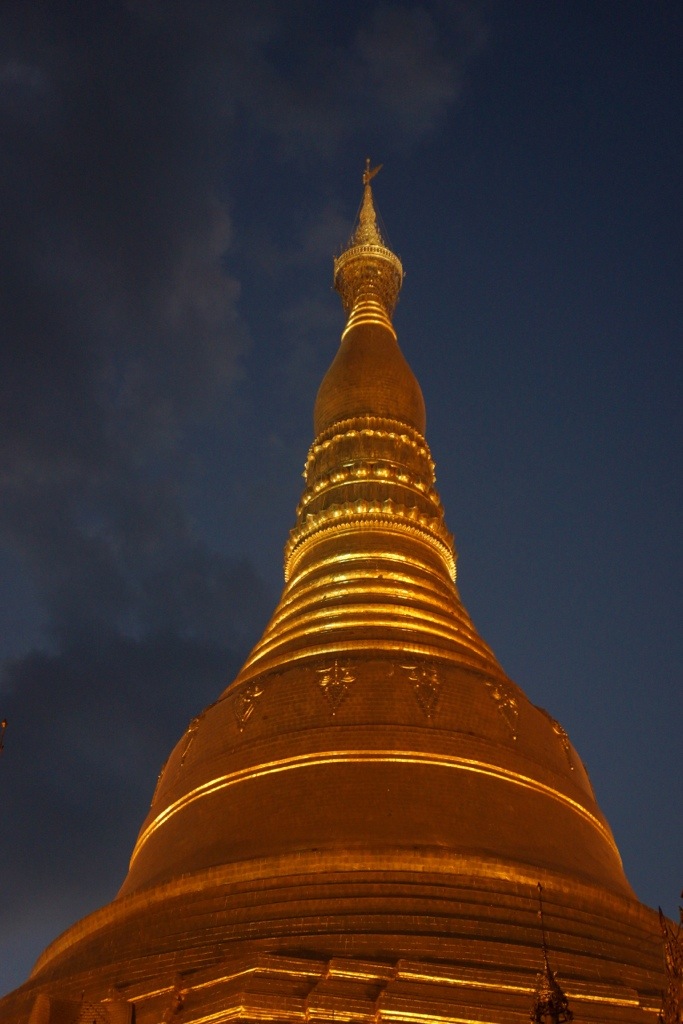
Thiri and Hillary join us for a delicious dinner at the Governor’s Residence and we retire, awaiting a 4 AM wake-up call.
January 27
After breakfast at the hotel, we head for a return visit to U Hla Win’s gallery, but, as we are early, we walk through a market near Hillary’s apartment. It’s nice to see a market at which there are no tourists, though Hillary indicates that this is a market frequented by richer people, who drive there.
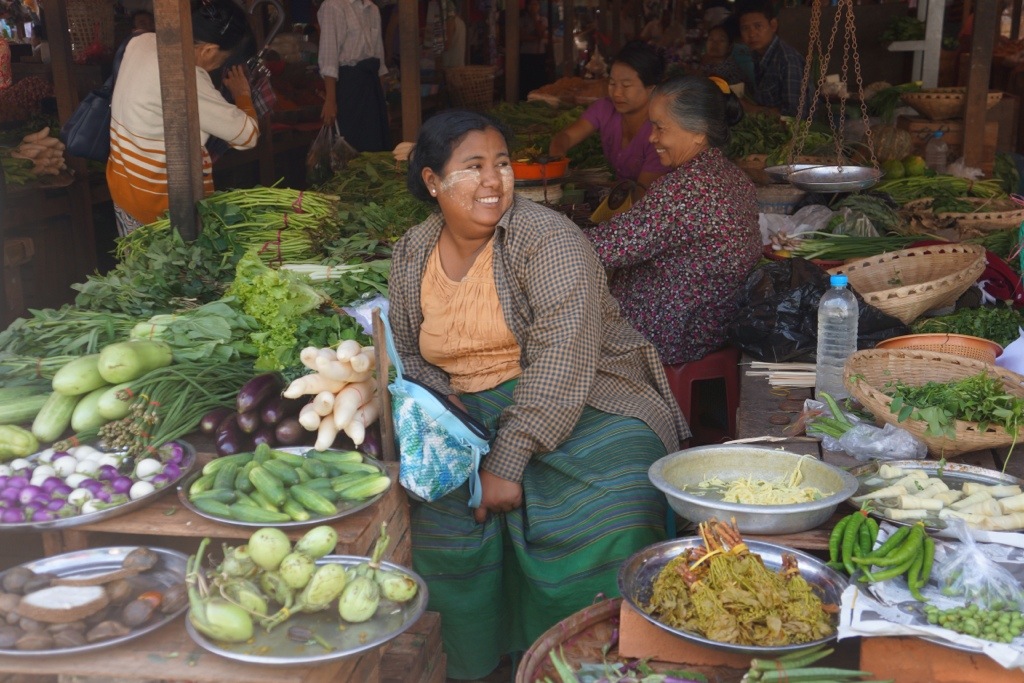
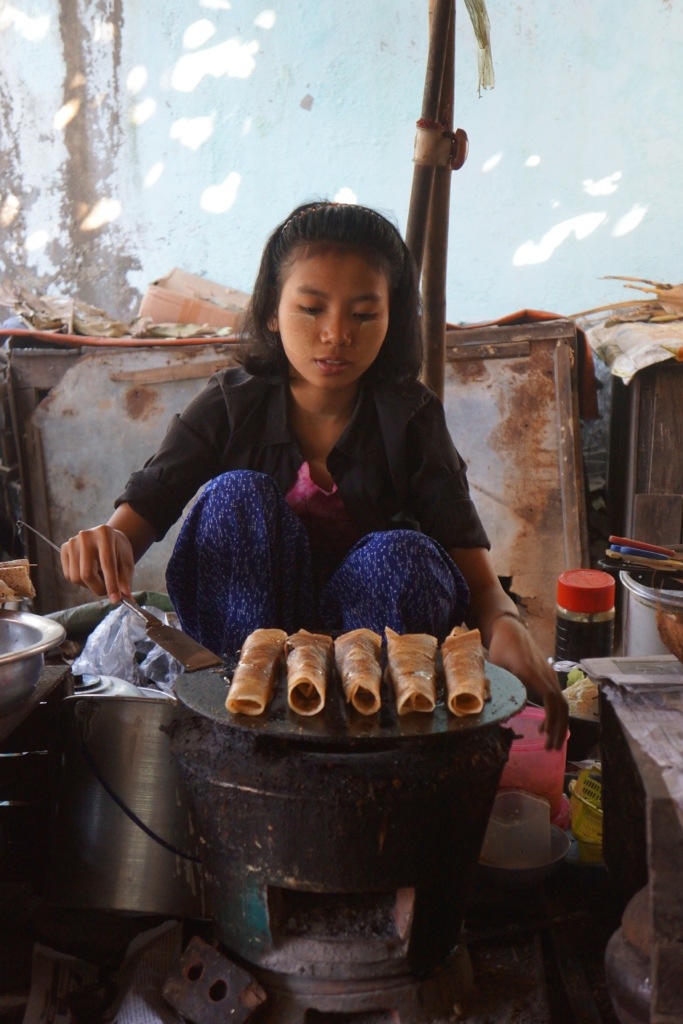
We spend another hour with U Hla Win, who enthusiastically shows us around again. There is a watercolor that both Carol and I like, and we’re mulling it over. May depend on whether U Hla Win is prepared to move off of his “fixed price.”
We head down to the jetty to take a huge ferry over to Dalla, a fifteen minute ride. For foreigners, the ride is two dollars each way. For the working class folks who commute to Yangon daily, the ride costs 4 cents, each way. Hordes of people walk onto the boat, ranging from monks to people in ordinary dress to some who are dressed to the nines (for reasons we will later discover). Vendors on board hawk everything from watermelon to cigarettes to shirts to trinkets (including a plastic snake we purchase for Jasper). It is quite a scene.
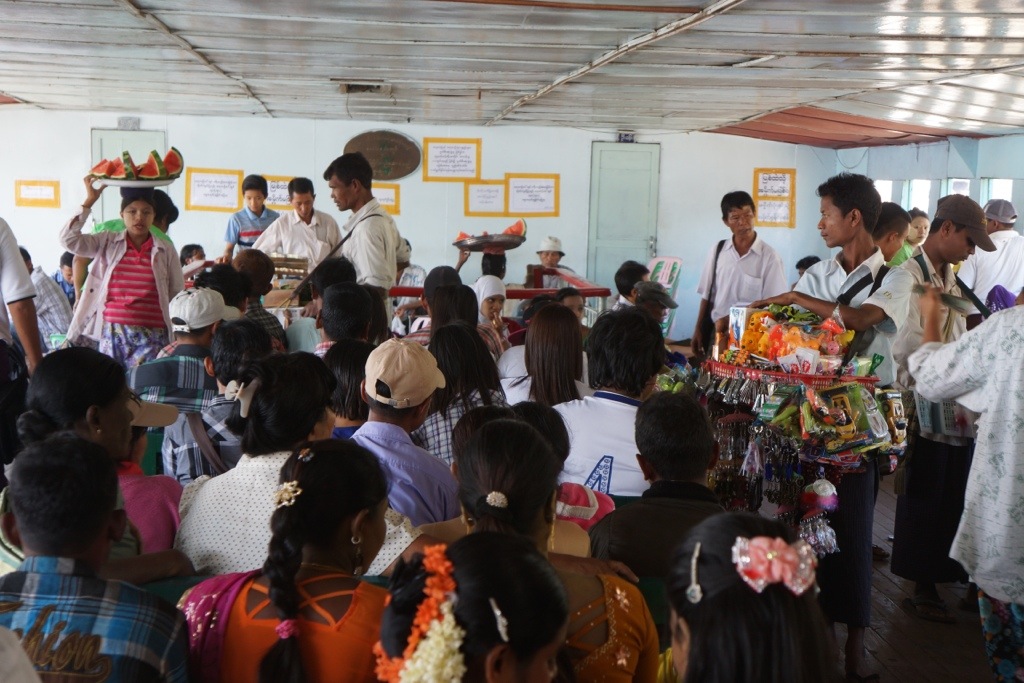
On the other side, Hillary and Carol to bargain for two trishaws, bicycles that have a side platform that will sort of fit two people, one facing front and one rear. Carol and Hillary share a trishaw.
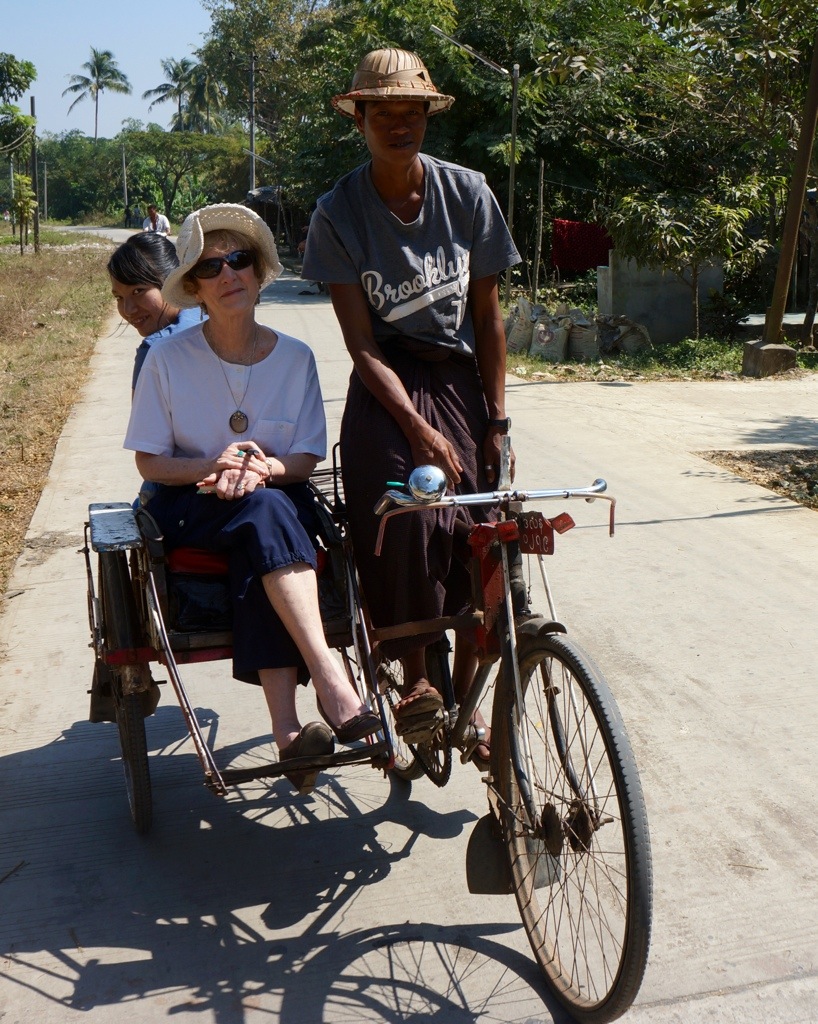
Our drivers pedal us around town, stopping at a modern pagoda that looks a bit like an amusement park, which houses both Buddhas and nats, and then at a Christian orphanage, where a service with lively music is taking place. The orphanage houses 17 kids, including the five children of the man who runs it and his wife. We leave a donation and move on.
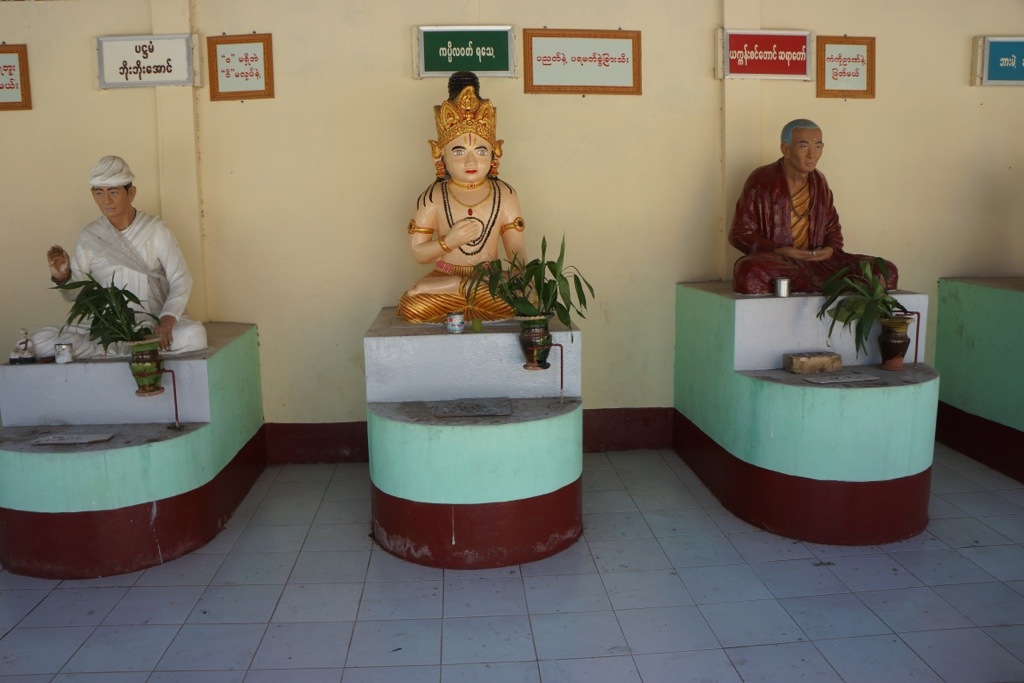
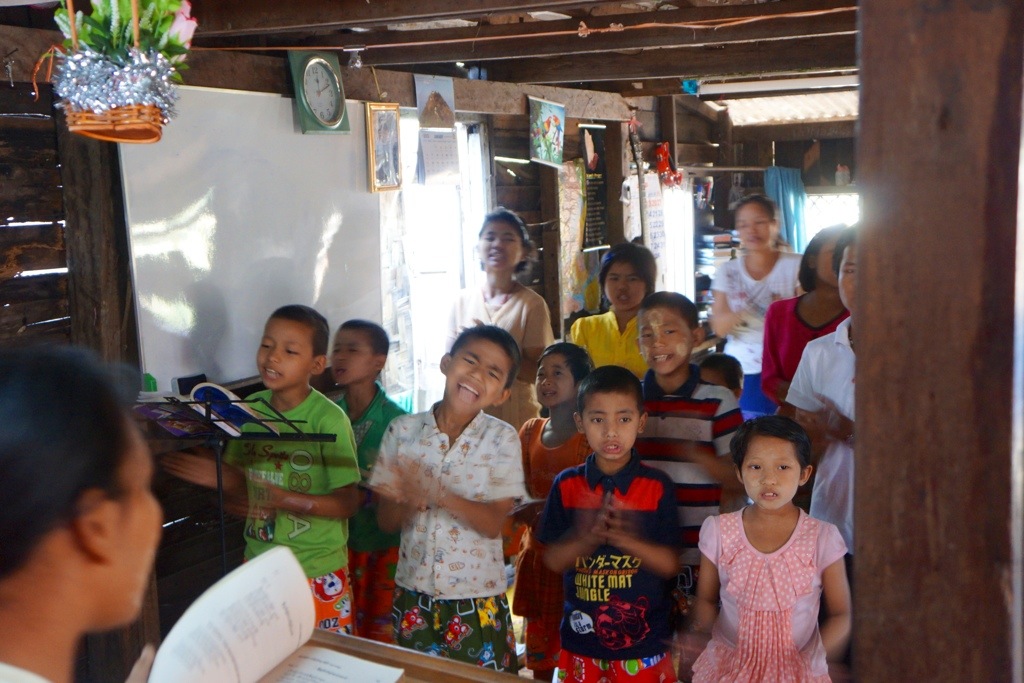
We pass a spot where Hillary says a wedding is going on. When I ask whether we are invited, Hillary asks if we’d like to go, and I say, “of course.” We are welcomed warmly and invited to eat (we decline). It is an Indian-style wedding, and this being the fourth of these that I have crashed (the other three on three different trips to India), I am now entirely comfortable pushing to the front, taking photos and greeting family members. It’s a festive affair with a loud band and a distinctly non-traditional dance by a young Indian woman. This solves the mystery of the fancy dresses on the ferry.
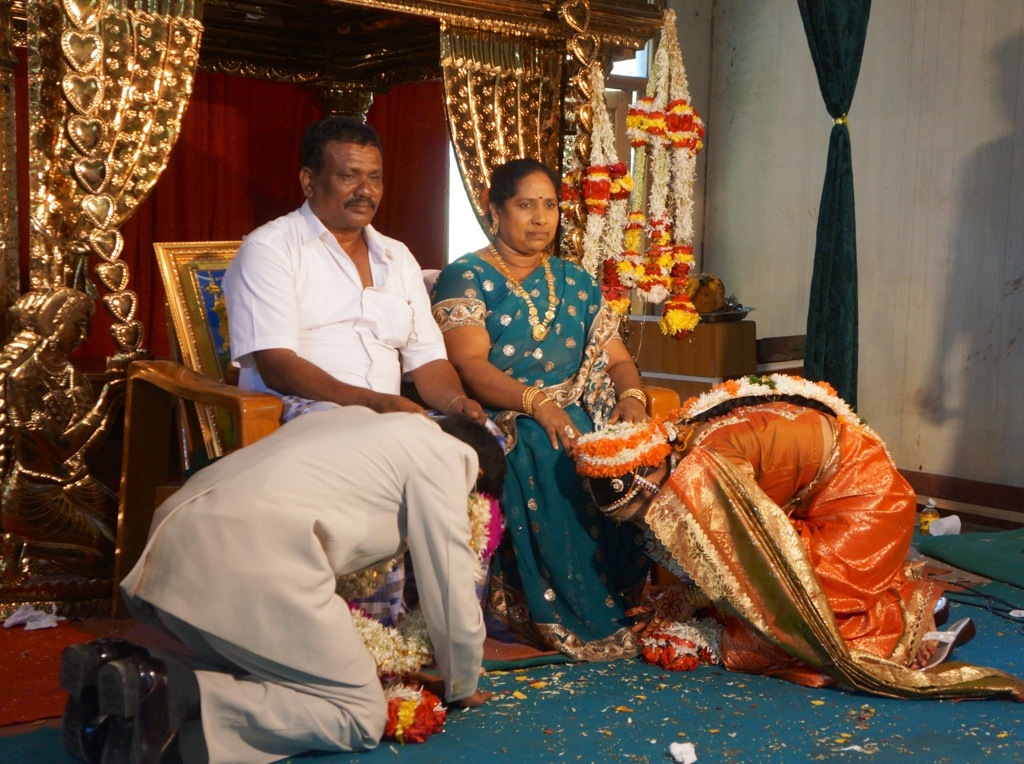
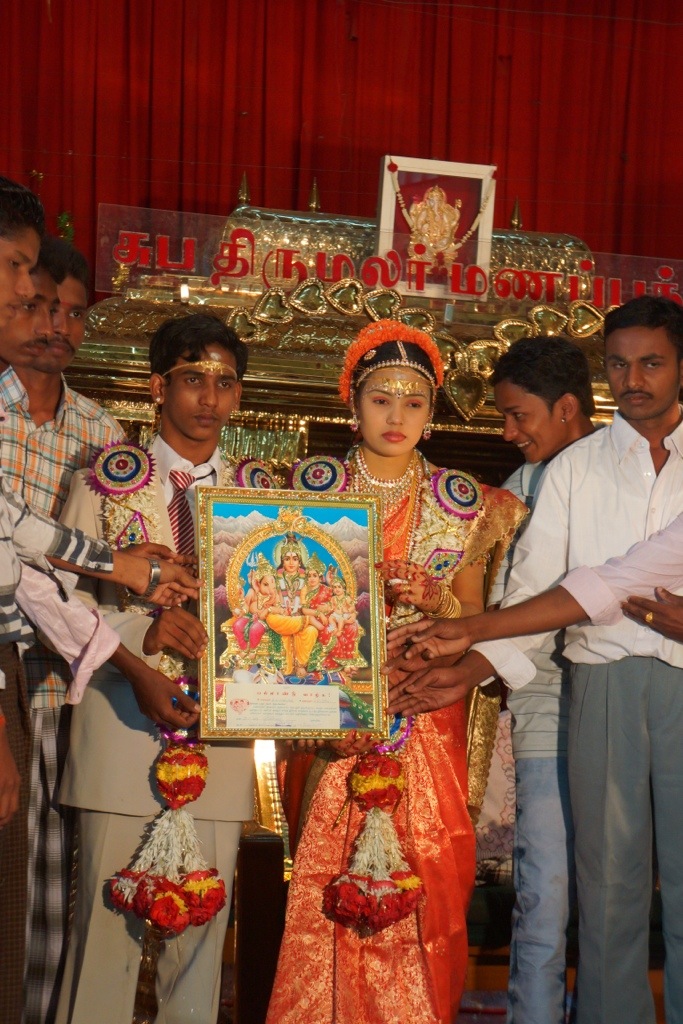
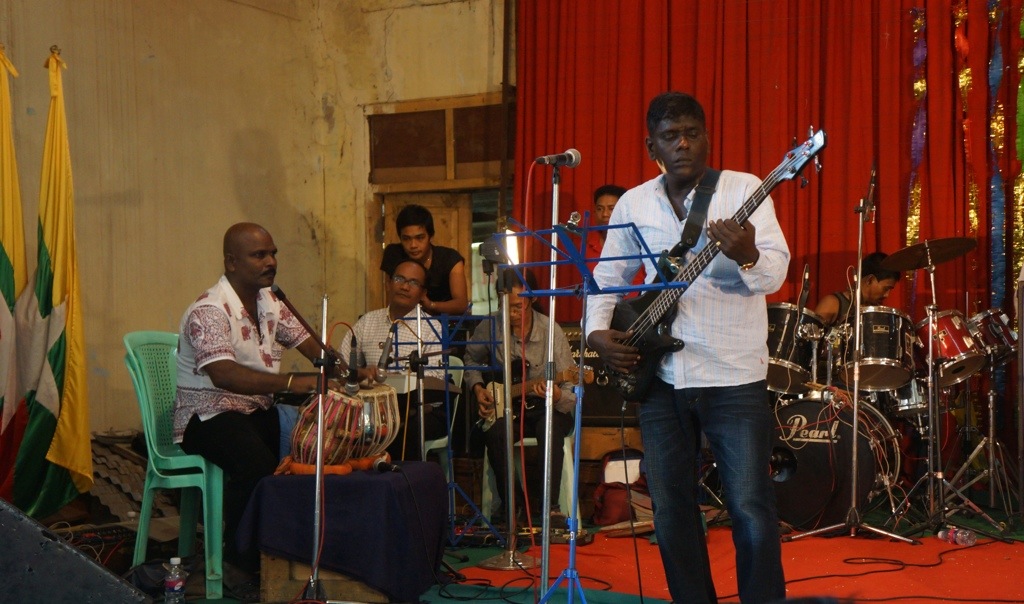
We ferry back and drive to a spot for lunch, before moving on to the home of Damon and Stacy Zumbroegel, friends of Dotty, and our connection in getting to U Hla Win. Damon was a very successful architect in San Francisco and has had a long-standing interest in the Far East. He’s been coming to Yangon for nine years and moved here two years ago, Stacy and their two small daughters joining them a year ago. He has retired from his architectural practice in the US, which has spawned half a dozen other successful practices, since he left. I’d say he’s about fifty.
Damon thinks that the dramatic changes we’ve seen recently have been in the works for years, and decided to come here before any of it surfaced. A couple of years ago, when he and Dotty wanted to talk, they had to do so in a whisper at the back of a coffee shop. two years ago, he could not teach a meditation class, because it would bring more than five people together. the number of ex-pats, which was at about 200 a year ago has swelled to around 2000. He is certain that Daw Aung San Su Kyi will be elected president. She is, he says, “the real deal.”
Damon is completely unabashed in talking about the for-profit opportunities in Myanmar, and plans to establish a unique brand of hospitality-based operations around the country. He will use these as a base for sustainable growth to provide all the necessities of food, clothing, medical and shelter through a non-profit entity or entities he is creating. Damon has a clear vision of what he wants to accomplish. He calls his project Vihara, and subtitles it “sustainable hospitality in a peaceful abode.” At this point, he has half a dozen Americans and about ten Burmese working for him. His initial developments will be outside Yangon and in Bagan, where he has already acquired land. He’s to send me details, and I hope that we will stay in touch.
We returned to our hotel for a few hours of rest and blogging. Hillary picked us up and took us downtown to an Indian storefront restaurant, with waiters and staff shouting back and forth at each other. Our dinner was nicely-paced as we were done in roughly 22 minutes, at which time I paid our $5 tab (no tip necessary). I decided to save the goat’s brains with rice dish for our next visit, though it certainly was tempting.
Beer and snacks back in the very peaceful hotel bar, before retiring for the night.
January 26
Picked up at hotel at 7 AM for a horse cart ride. We’d resisted the obligatory horse- and ox-cart rides until now, but decided that they were in fact obligatory. Did not see monks lined up for alms, as we’d hoped to, because our timing was off. But the slow ride among some of the non-famous pagodas in the chilly (sweater and jacket) early morning light is rewarding. One does see a distressing amount of trash this way, however. Above us the balloons we rode in a couple days ago glide over the pagodas. The horse cart ride provides glimpses of life that you don’t see from a car. Stop briefly at Ananda Pagoda, with the huge standing Buddhas. The place is jumping with people coming for full moon day of the festival, with processions of the faithful arriving with gifts. Return to the hotel after an hour, glad that we’d opted for the horse cart experience.
After breakfast, I wander down by the river and am able to photograph people in their huts by the water, because I know the secret word, “mingalaba,” hello.
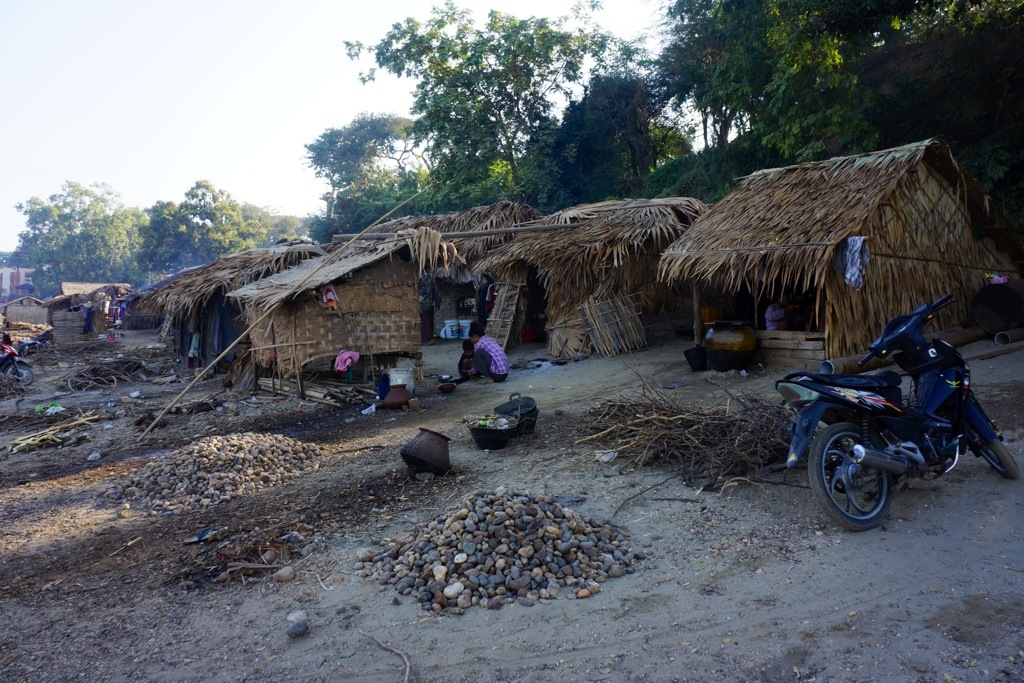
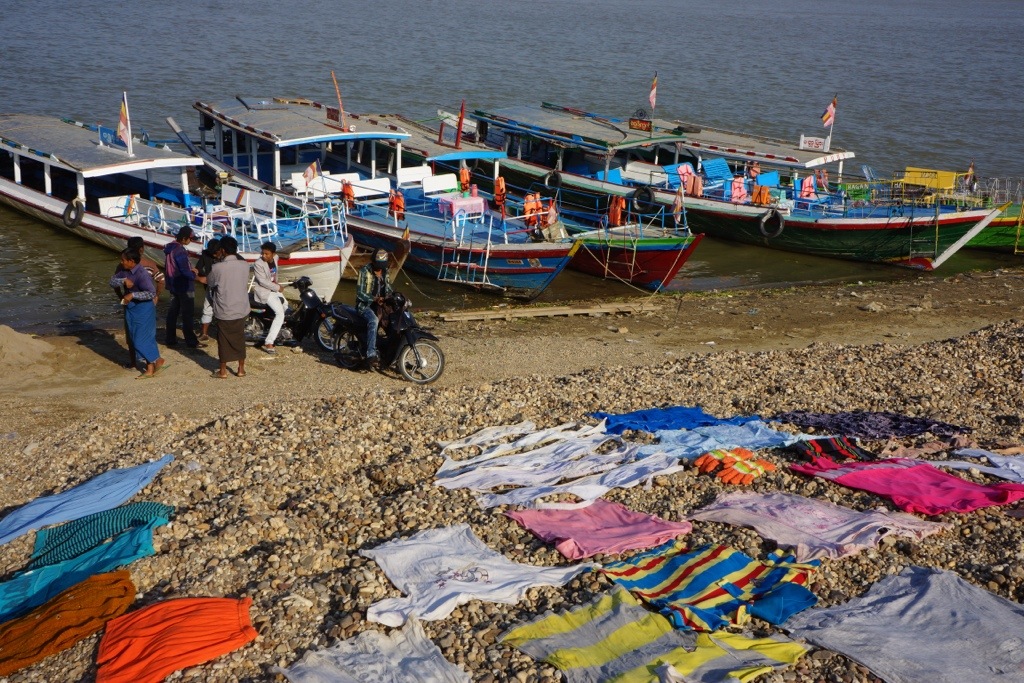
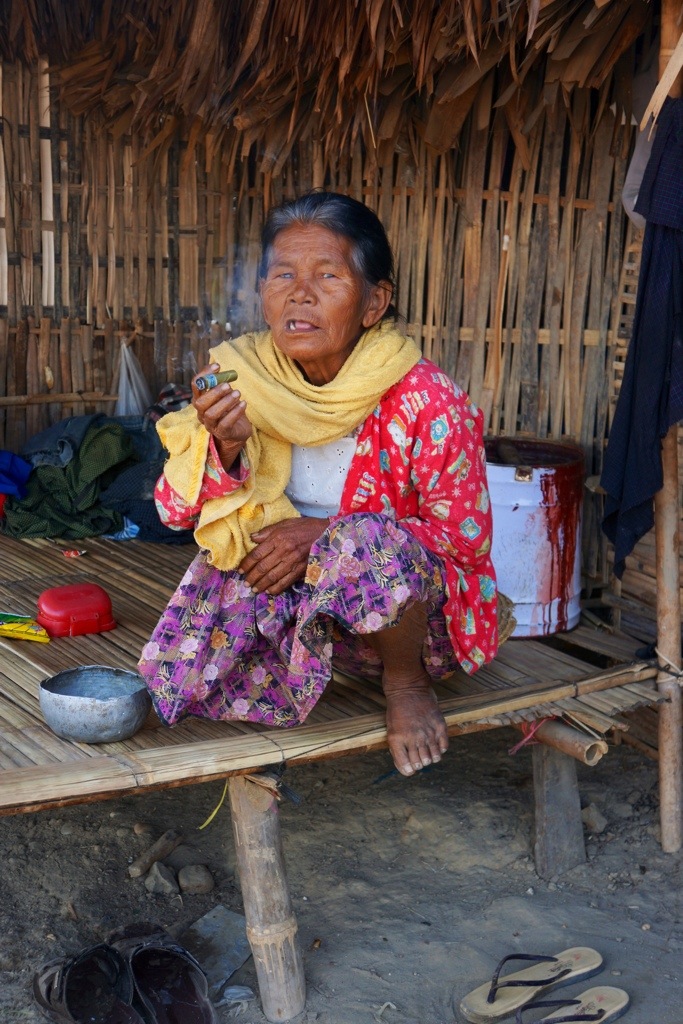
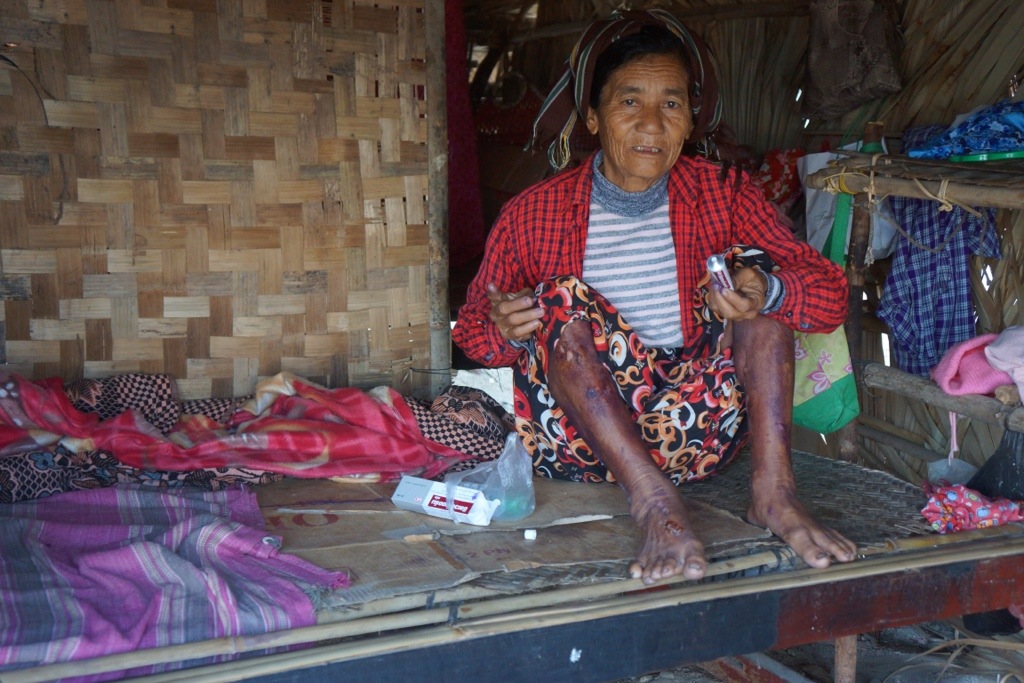
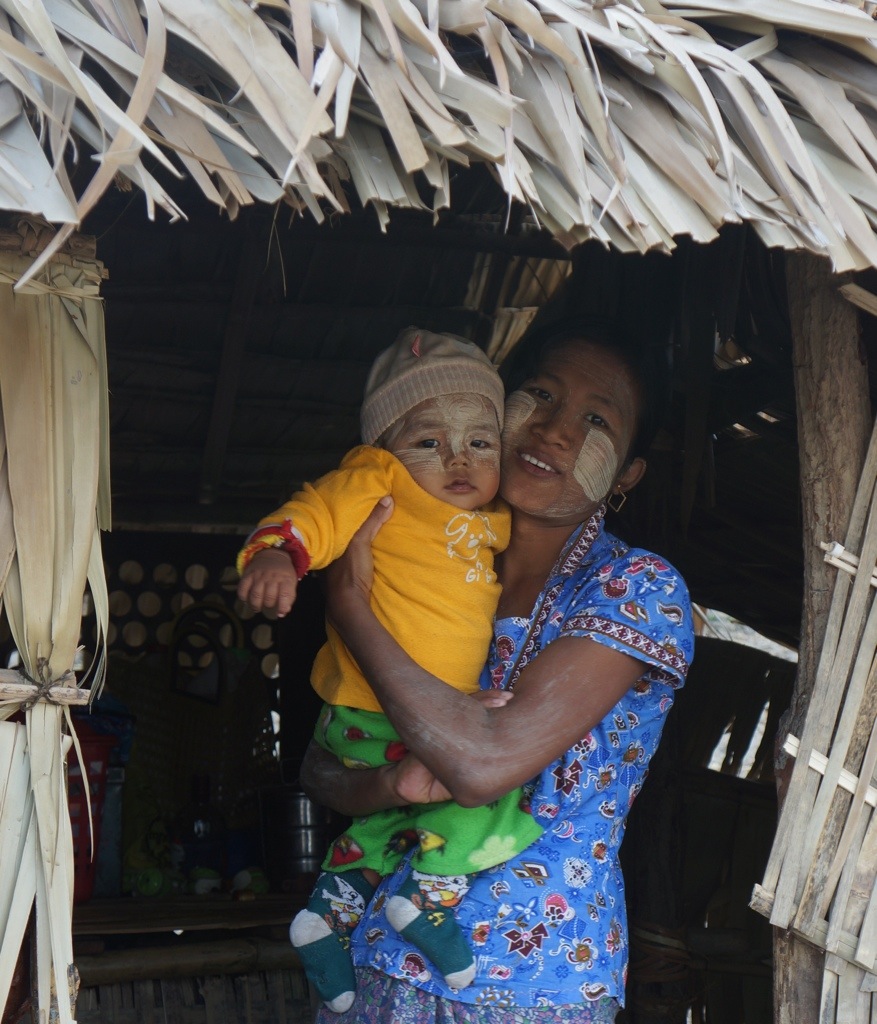
Back at the hotel, we read, blog, begin to pack and get ready for lunch with Dee Dee. Sit out on our balcony overlooking the river.
We take a taxi through the crowded town to Sunset Garden Restaurant, which is managed by Dee Dee’s father U Min Min Aung. Several tour buses attest to the restaurant’s popularity. Dee Dee comes running out to the parking lot to greet us and takes us to the best table, which has been reserved for us, overlooking the Irrawady. Her father and mother, Daw Khin Lay Win, who Dee Dee looks like, come over to greet us, as does her husband, who is there with people he is guiding. Dee Dee has ordered a large lunch for us, and leaves us alone to eat, as she says she had a late breakfast. We are not allowed to pay and, in fact, Daw Khin Lay Win gives us gifts of hair clips for all three granddaughters. We say goodbye to everyone, taking Dee Dee’s email address so that we can stay in touch, and leaving a CD of American music as a gift.
Our taxi driver has waited at the restaurant to drive us back to the hotel, where we have two hours before leaving for the airport, and one before we need to vacate our room. Uneventful ride to and wait at the airport, and somehow half the nation of Japan manages to board our hour and a quarter flight to Yangon (which takes off 15 minutes prior to scheduled departure), once again on the airline on which elephants fly.
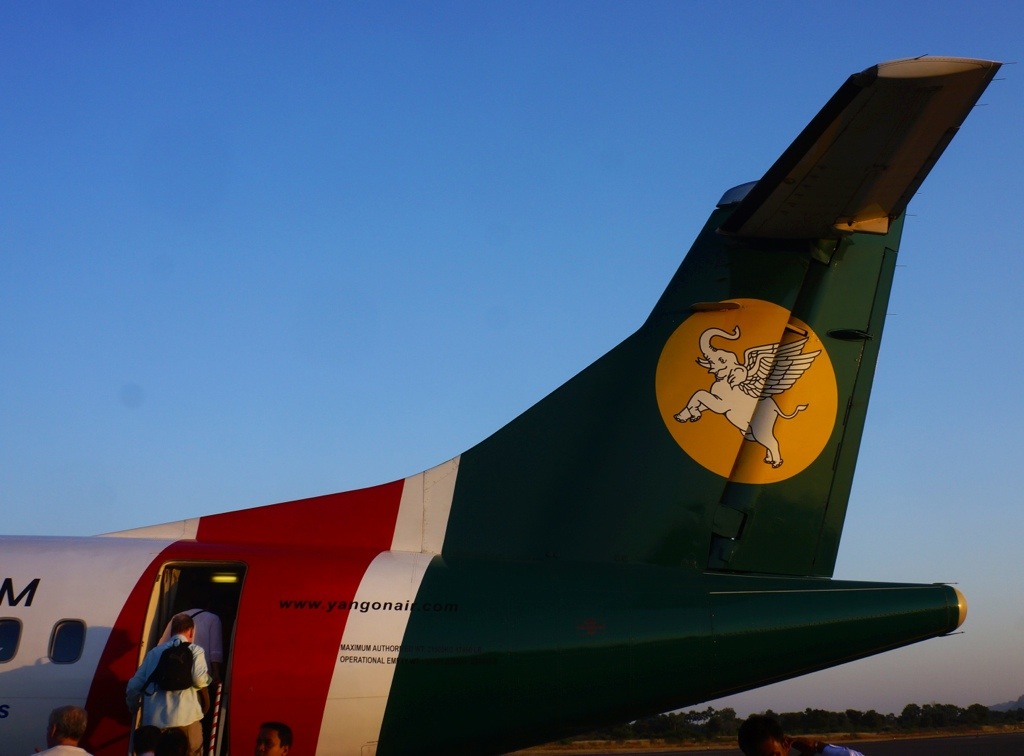
We are sad to leave Bagan, which has a magical quality to it. We know of no other city remotely like it. Imagine an American city with lovely and distinctive 1000-year old, spiritual Starbucks sprinkled liberally around. No, on second thought, don’t. The only city we’ve visited that comes to mind as having something of Bagan’s magical quality is Venice.
Arrive in Yangon on schedule and Hilary meets us and rides to the Governor’s Residence. She has never seen the place, except from the outside, and seems quite blown away by the elegance of the property and our room. She is a “foody” and takes photos of each course. It’s fun for Carol and me to see her enthusiastic response to dinner.
January 25
After buffet breakfast, we are picked up by Dee Dee and driver and we head to the market at Nyaungoo. This is the largest market in Bagan and is more interesting than the one we went to a couple days ago, catering more to locals, less to tourists. That does not mean that there are not tourists around, but there are fewer spots aimed at them. Most places we go have street people selling postcards, copies of George Orwell’s book on Burma, hand drawn pictures by children and other things. And, while there are occasional beggars, begging is not widespread. As we weave around the market we see many nuns walking through, receiving alms in their bowls from people. This is not considered a form of begging, but the obligation of people to support.
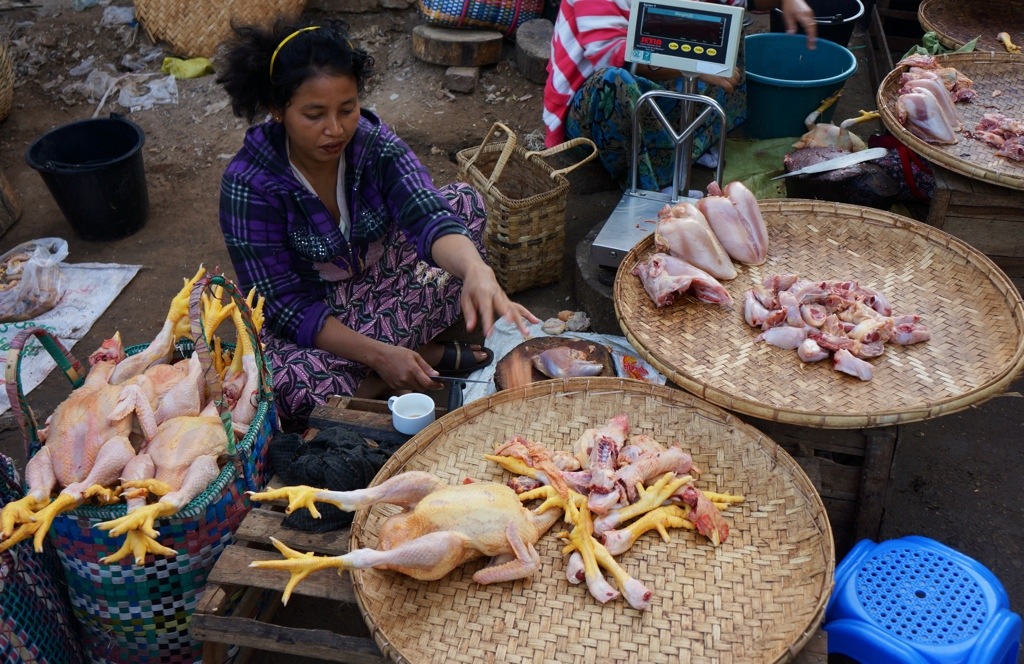
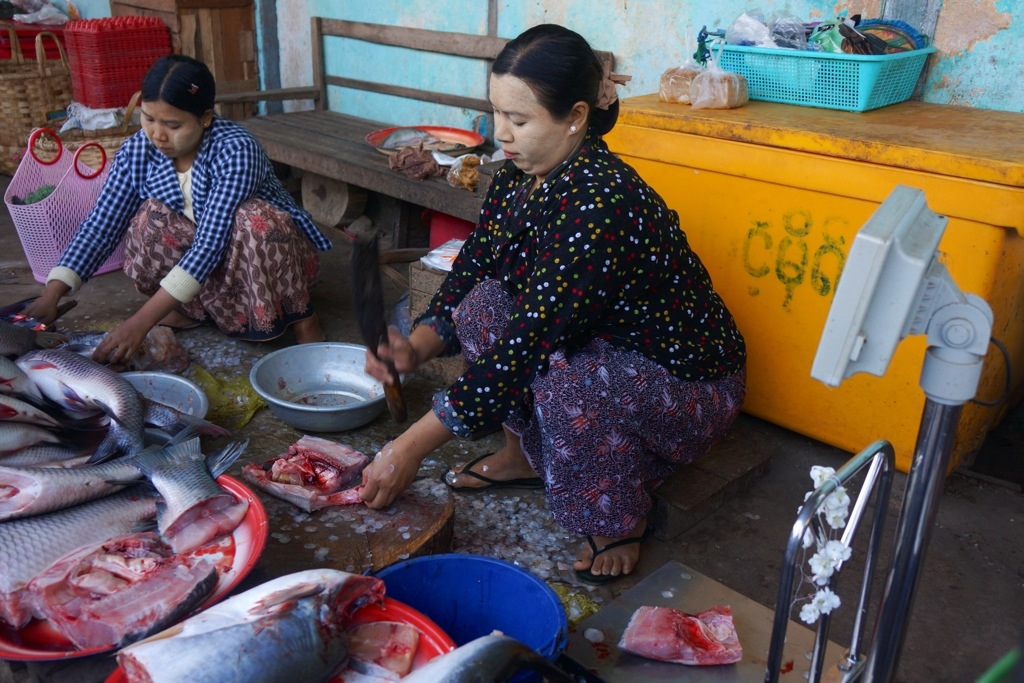
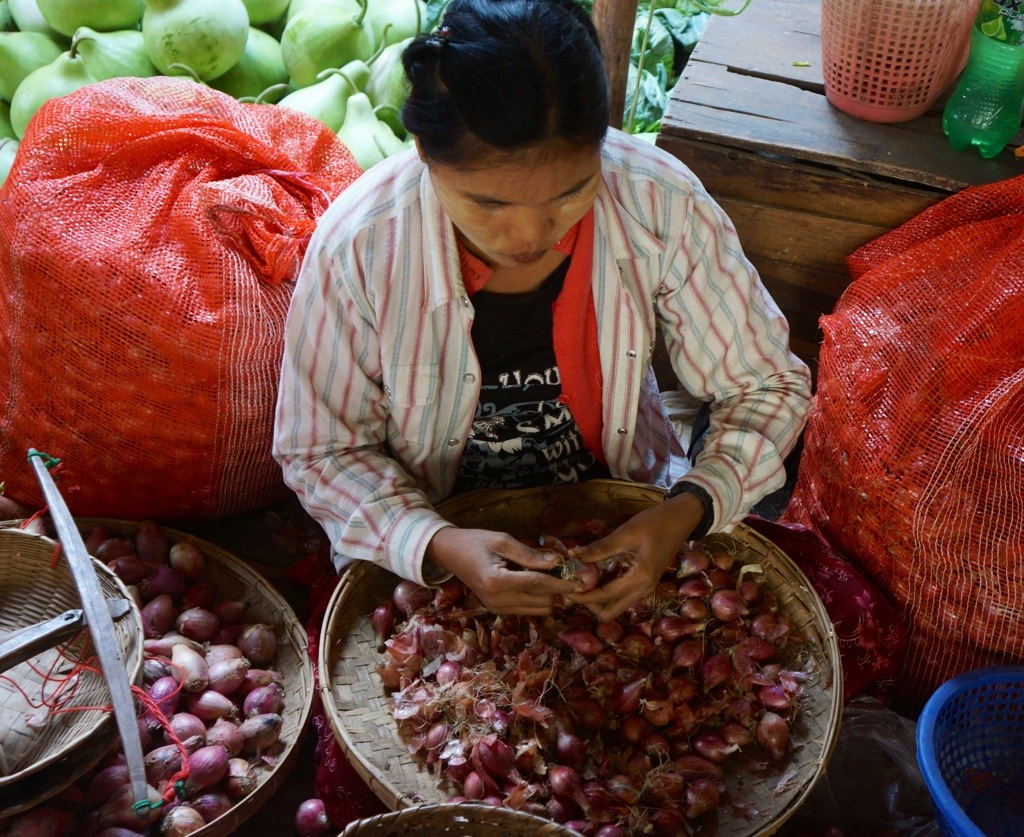
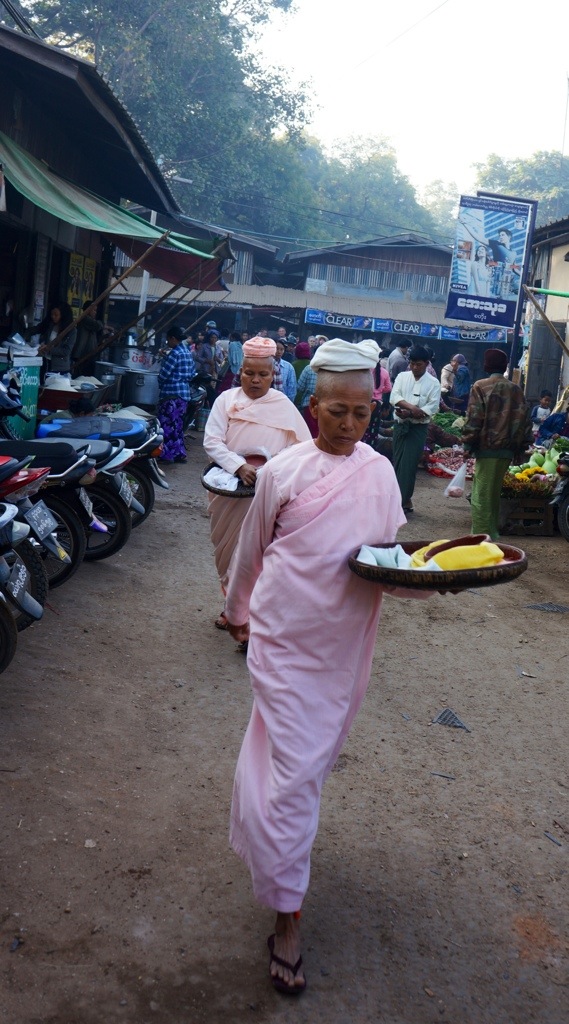
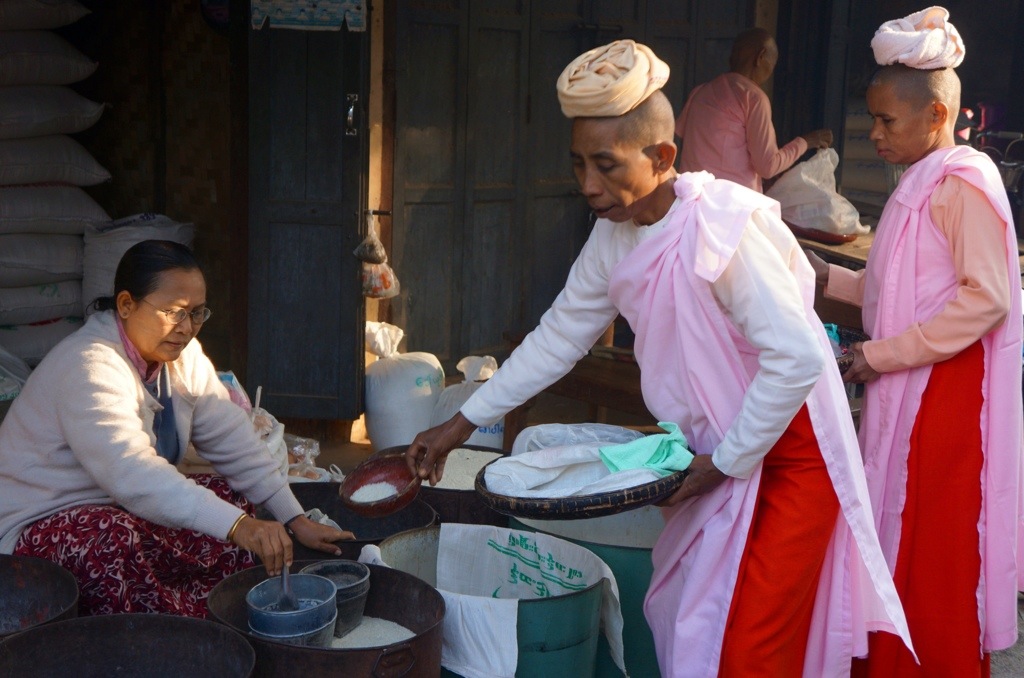
We go to visit two more temples. The first, Sulamani Temple, was built in the 12th century and has murals done in the 18th century.
The second, Dhamriayangyi, is the largest in Bagan and looks something like a pyramid. It has particularly fine brickwork; one can’t fit a pin between the bricks. It was built from 1163-65 by King Marthu. Like most of the buildings, the temple was damaged in the earthquake of 1975 and has been restored.
At this point, we are about temple/pagodaed out. In part this is because Dee Dee is not a fount of information about these places. She is as much a companion, and a delightful one, as a guide. To be fair, though, even if she were a fount, there’s a limit to what we can/wish to absorb. I’m certain that Dotty’s friend knows infinitely more, but, since we might well not have understood what he had to say, I think we’re a lot better off with Dee Dee.
En route to the Lawkananda Monastery, we encounter another group of young monk and nun initiates on horse back, and get out of the car to follow them a ways.
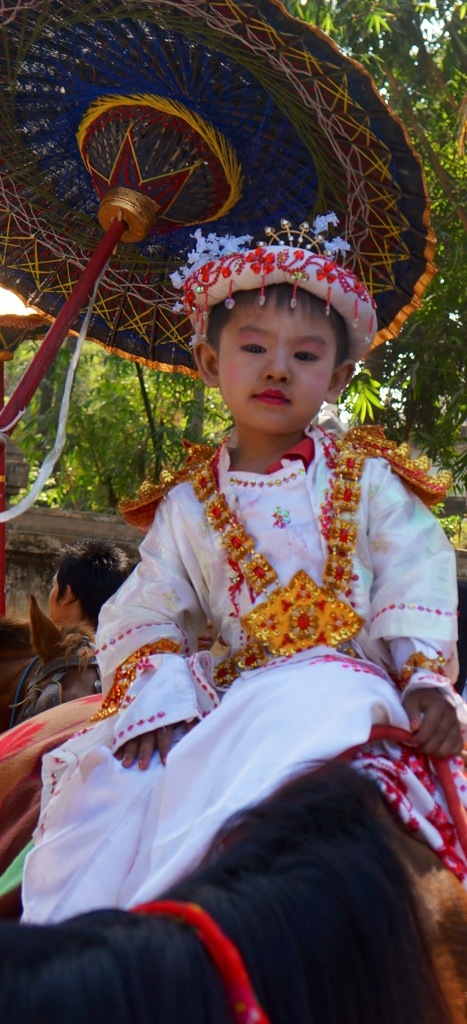
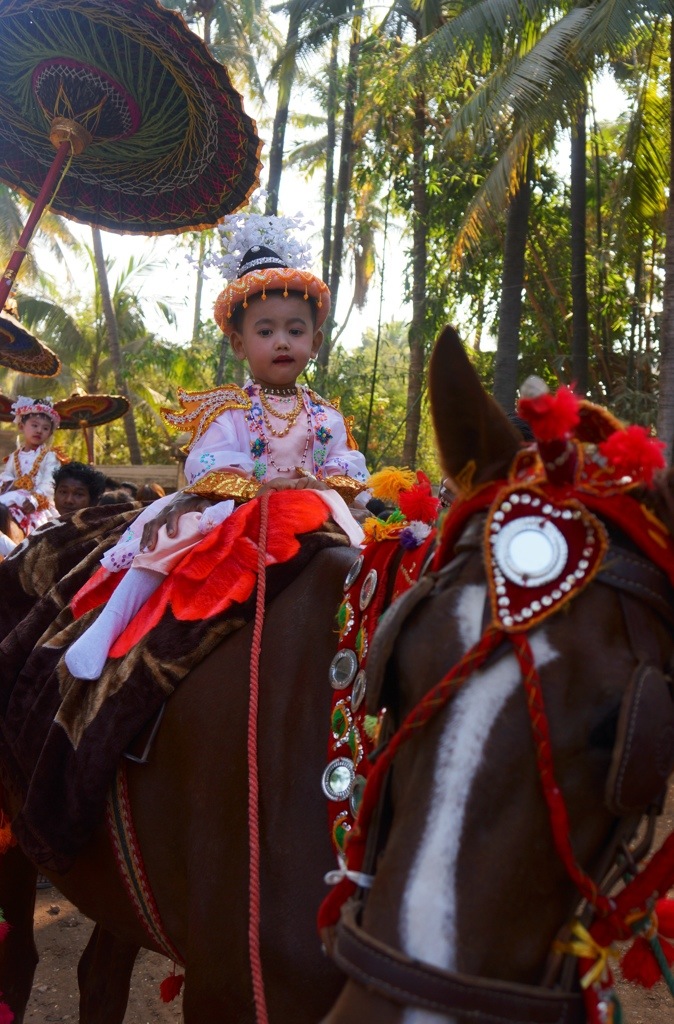
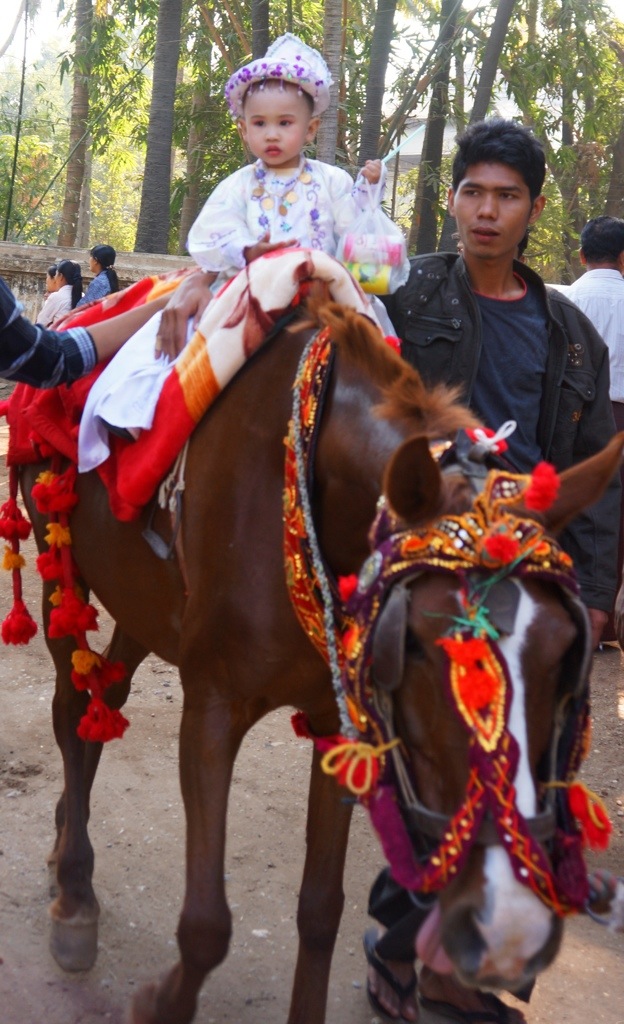
At the monastery, we see monks having their heads shaved and bathing. They line up for lunch with their bowls, local volunteers dump rice into the bowls as the monks pass and then they sit down on the ground at circular tables to eat in complete silence. A great treat for us and, surprisingly, except for one other couple that arrives mid-meal, we are the only visitors.
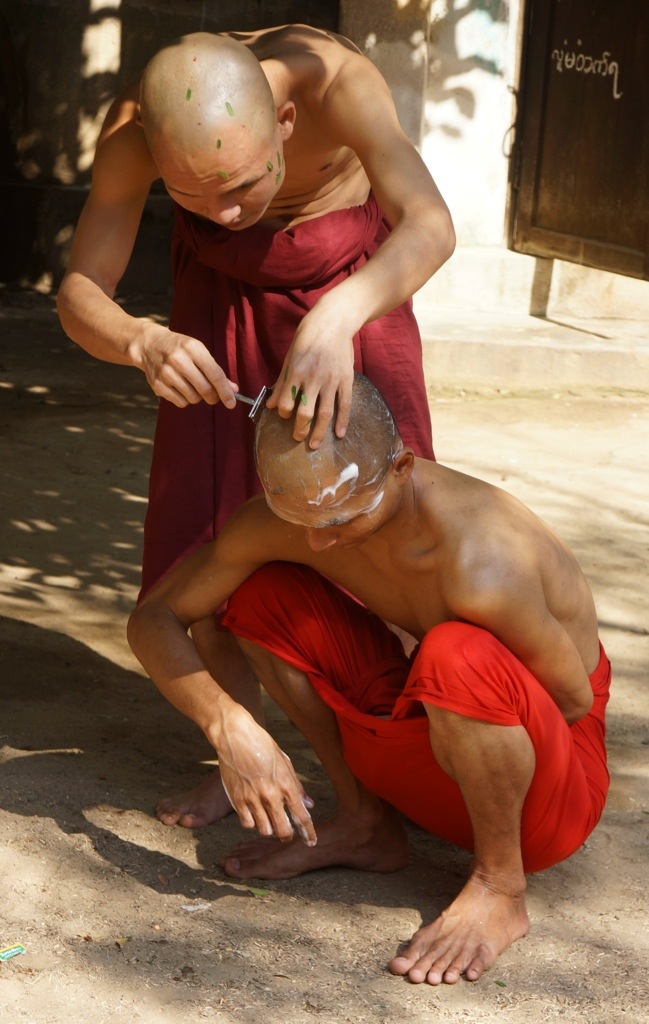
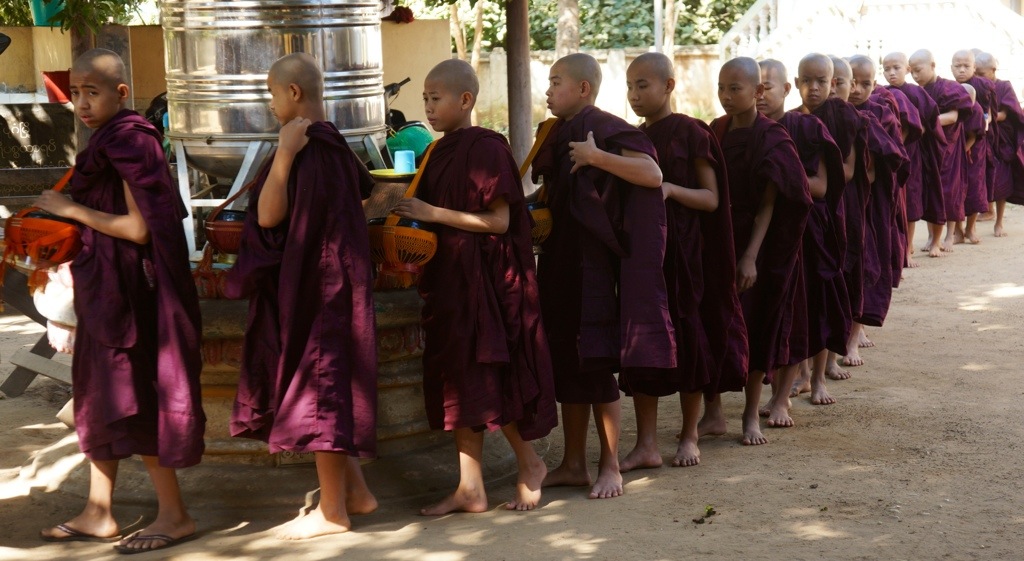
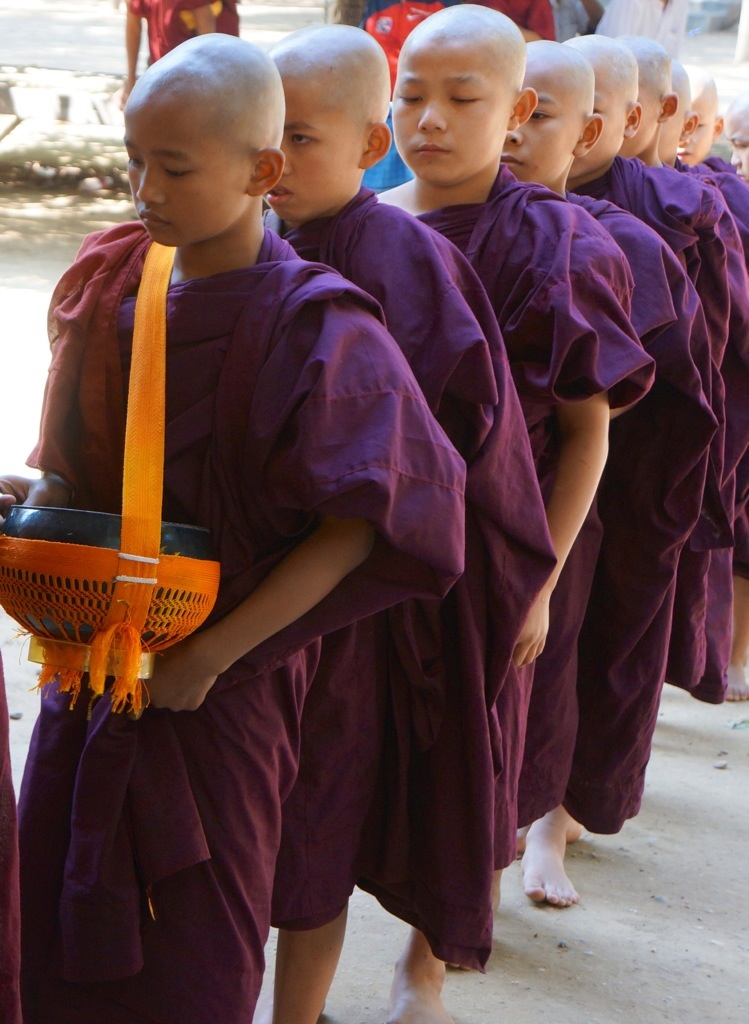
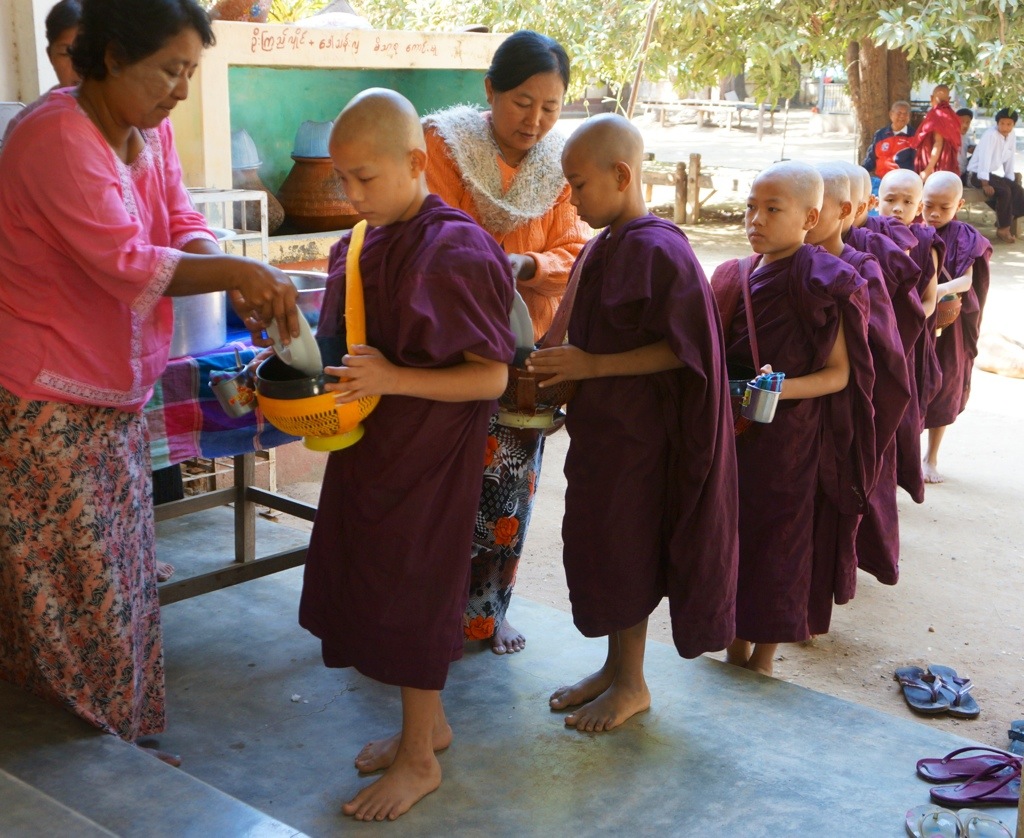
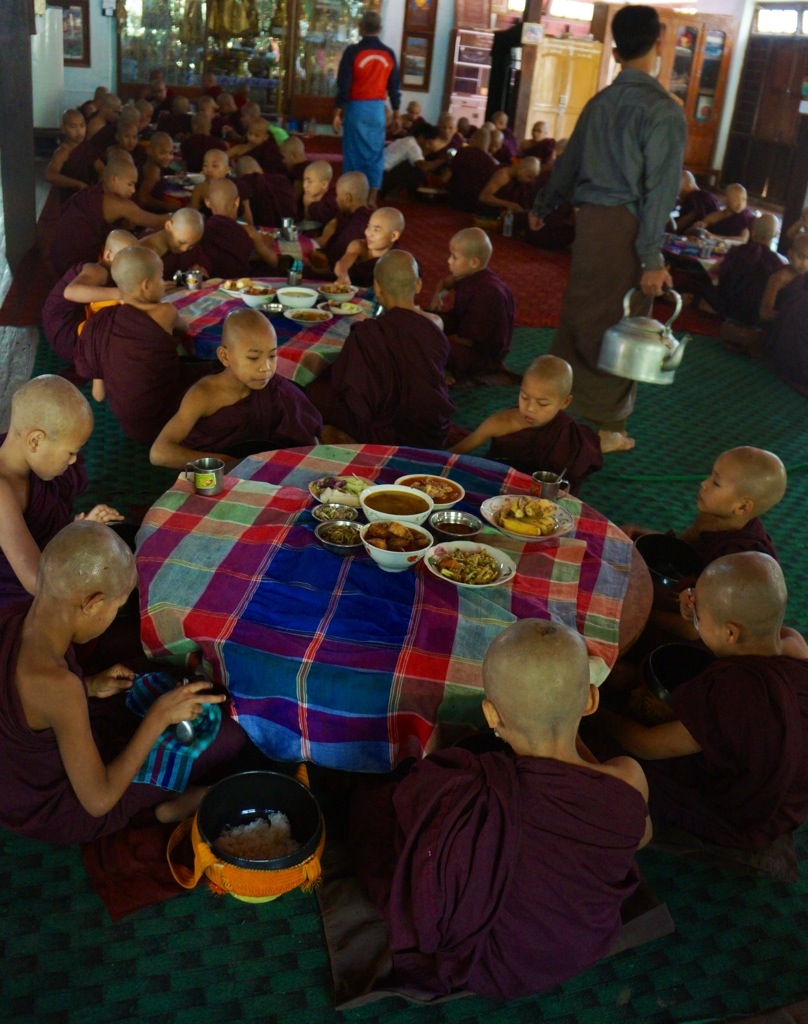
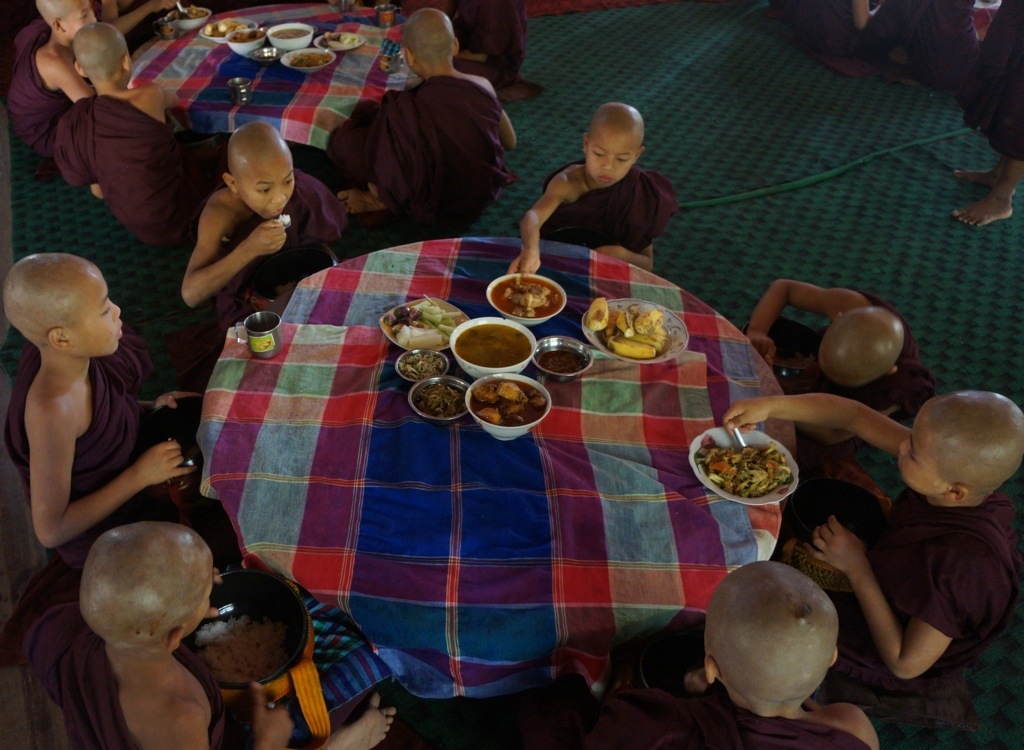
We drive to a lacquer store that the Feldmans had recommended, but don’t like either the work or the prices as much as the place we stopped yesterday, Mya Thit Sar, so we make a return visit. After considerable back and forthing, Carol makes a deal for ten very attractive bowls, each different, and negotiates a third off of the price, rather than the 5% discount the owner offered at first.
From there, we drive to Phwarsaw Village, where there are no other visitors. In fact, there are almost no other people, as most have gone to Bagan for the festival. Still, it’s interesting to walk around and see how people live. Most have bamboo dwellings, but “the rich people” as Dee Dee calls them, have plaster dwellings and water. We meet and talk with a few people, then have lunch served to us under a tamarind tree, with men fanning away the flies. It’s a special arrangement that Thiri has made for us. At lunch, we see Dee Dee’s wedding picture album, which she has brought at our request. She looks beautiful, but incredibly serious, in most of the photos. Several photos in the album are of Dee Dee and her husband with tourists who happened in on the wedding. I’m sure that Carol and I play similar roles in weddings in India.
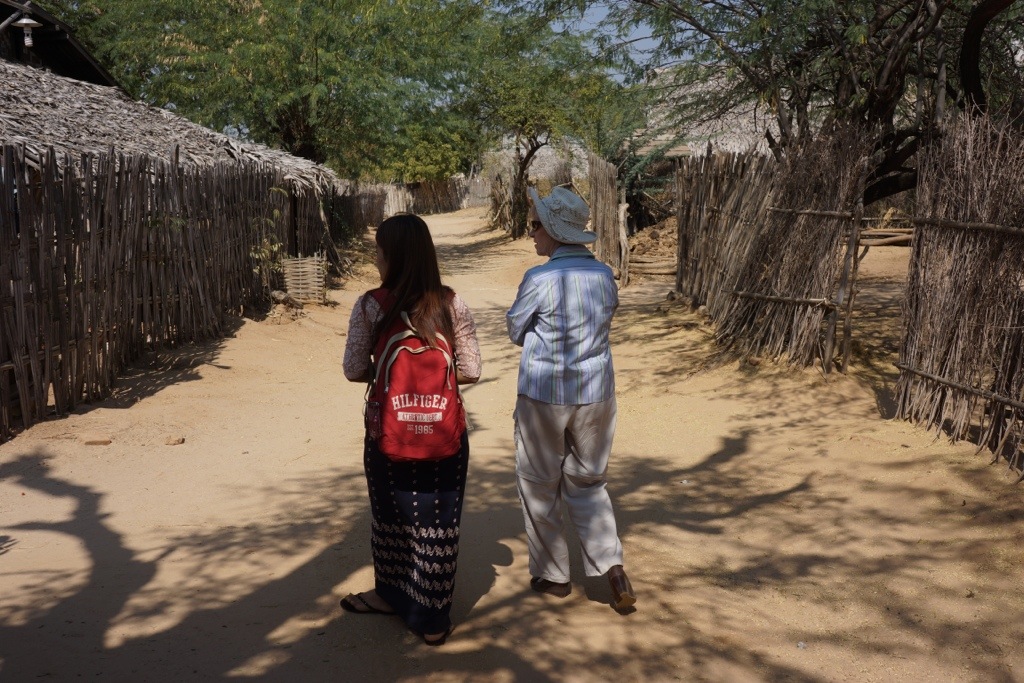
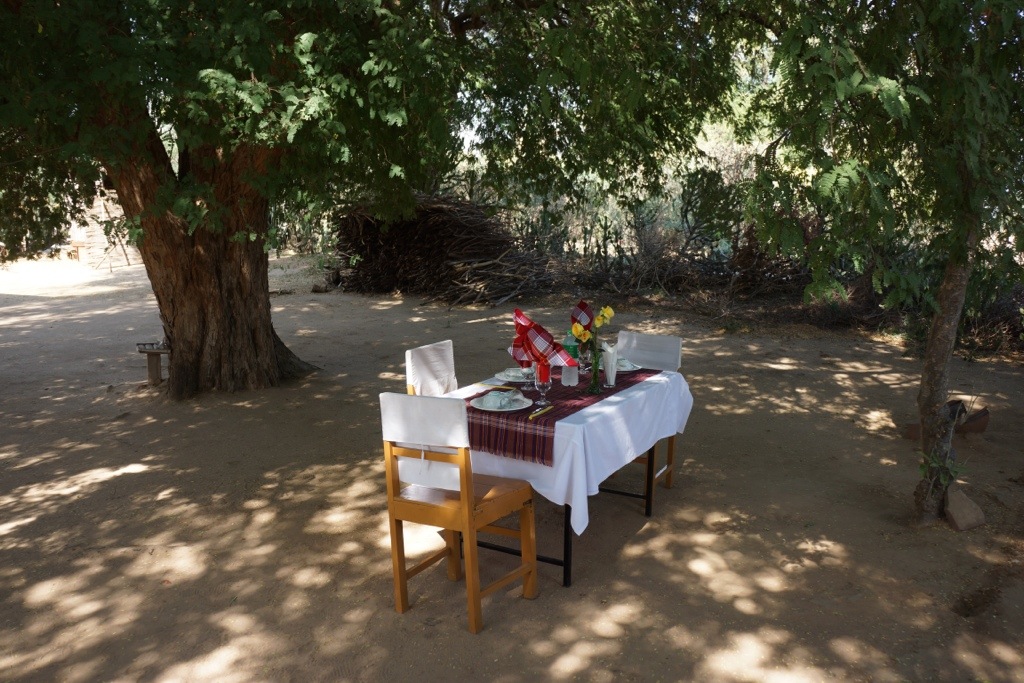
Back to the hotel for rest, blogging and picture downloading. We confirm tomorrow’s flight, arrange for a late check out and wait in the lobby for Dee Dee to drive us the very short distance to the river below our hotel where we have a private boat that takes us out to see the sunset. Talking to Dee Dee, we learn that her father manages a popular restaurant on the river, and her mother runs a souvenir shop there. At our request, Dee Dee says that she will meet us for lunch at the restaurant tomorrow.
We return to the hotel to clean up, having decided to eat at the hotel again tonight. Spring rolls and apple crumble again.
January 24
Good buffet breakfast at hotel and we meet our guide Dee Dee in the lobby. Dee Dee is diminutive, twenty three, a guide for three months and married a month ago. Her passable English and lack of seasoning are forgiven because she is beautiful and has a smile that lights up the place for miles around.
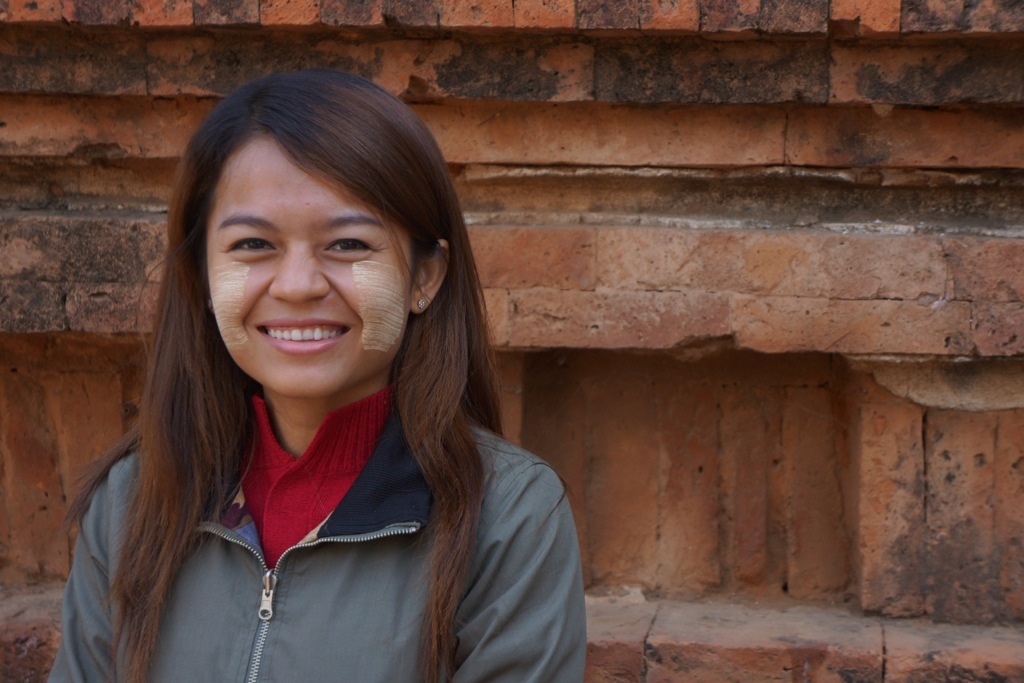
En route to Mt. Popa, we stop to see how palm oil, palm sugar and palm liquor are produced. An ox grinds peanuts as he walks around in a circle to create peanut oil. I ride behind, but Carol passes in favor of feeding him. We watch a man climb a ladder attached to a tree with two pots attached to his belt, cut off part of a high branch and replace two full pots of palm sap with the empty ones he’s carried up. After, we see the liquor being boiled from the sap and taste some of the strong liquor and the delicious, sweet sugar candy.
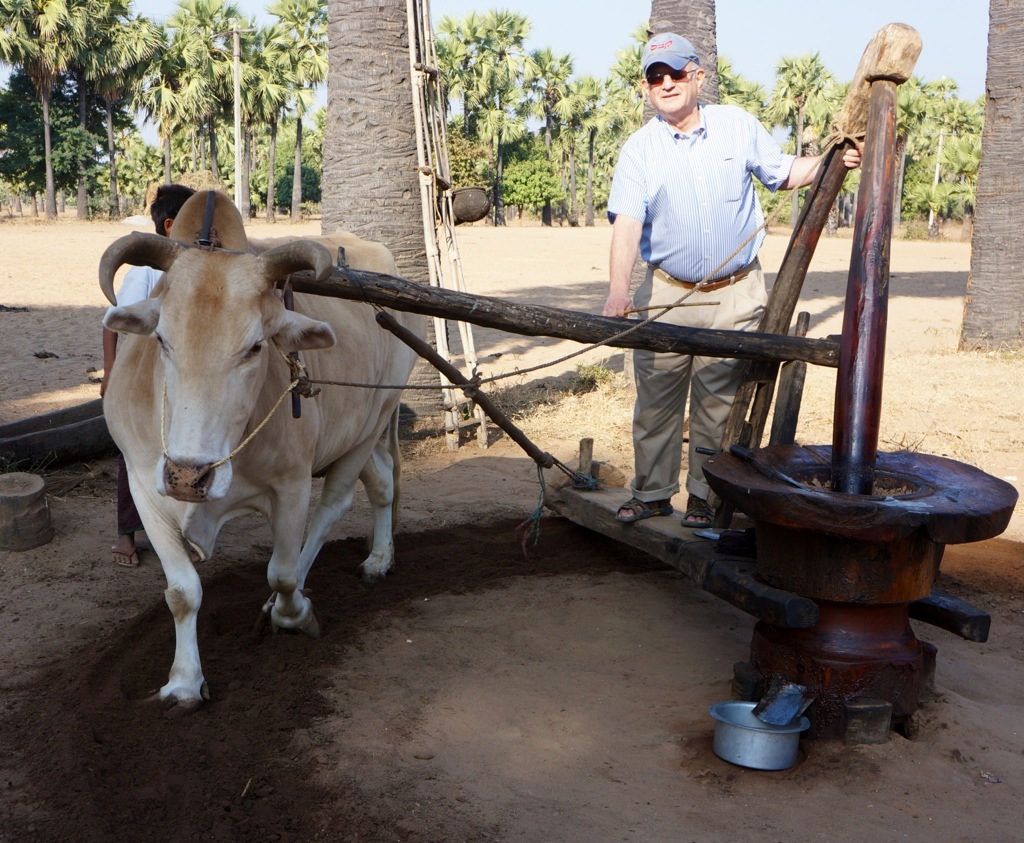
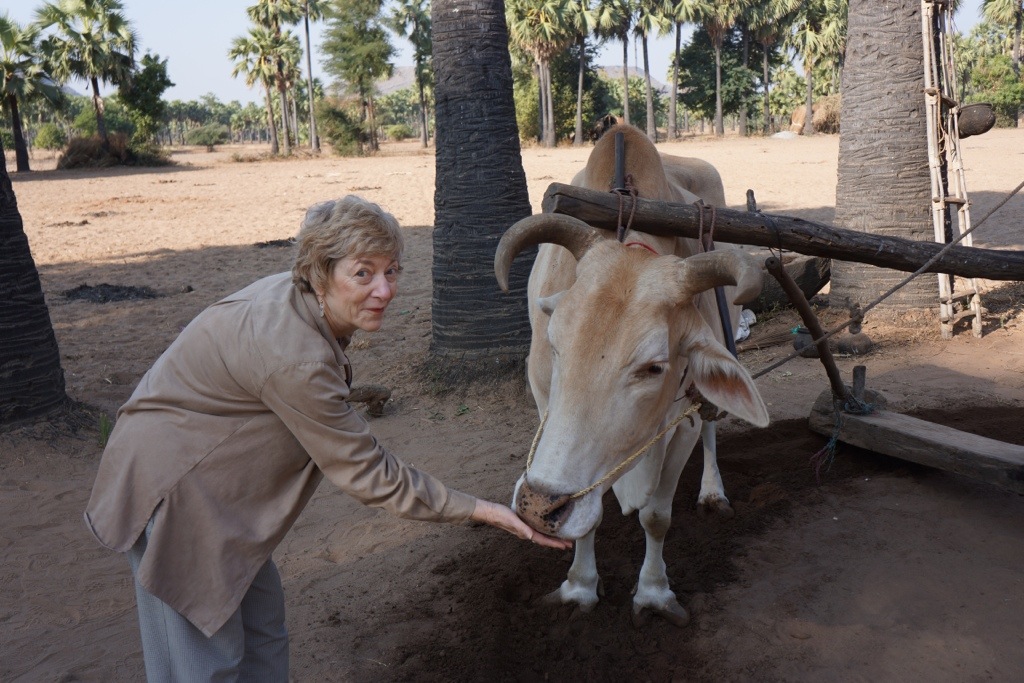
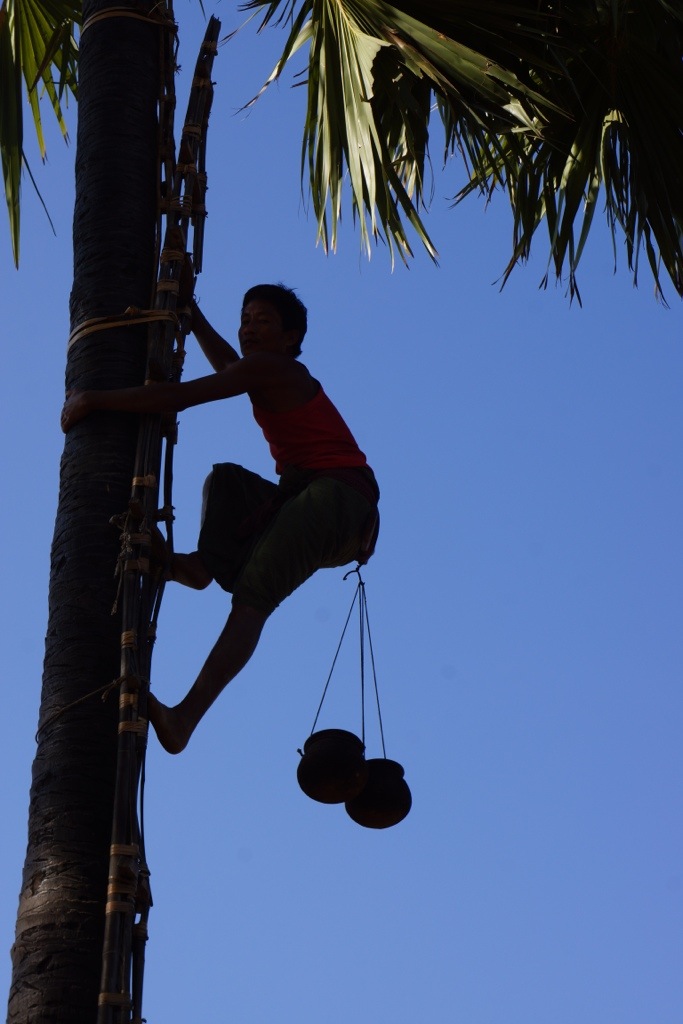
In a fortuitous happening, sure to be a trip highlight, we encounter young girls dressed in bright costumes being placed on horses for a procession that will lead to their ordination as nuns later in the day. Their parents are comforting them and a large crowd has gathered to listen to raucous music in a nearby pavilion.
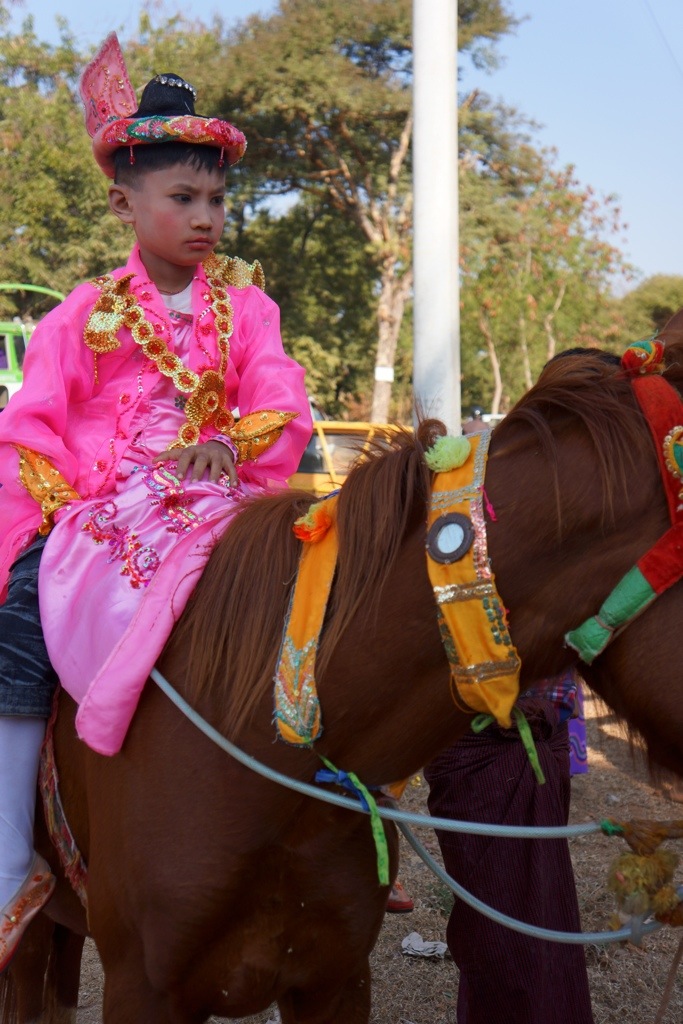
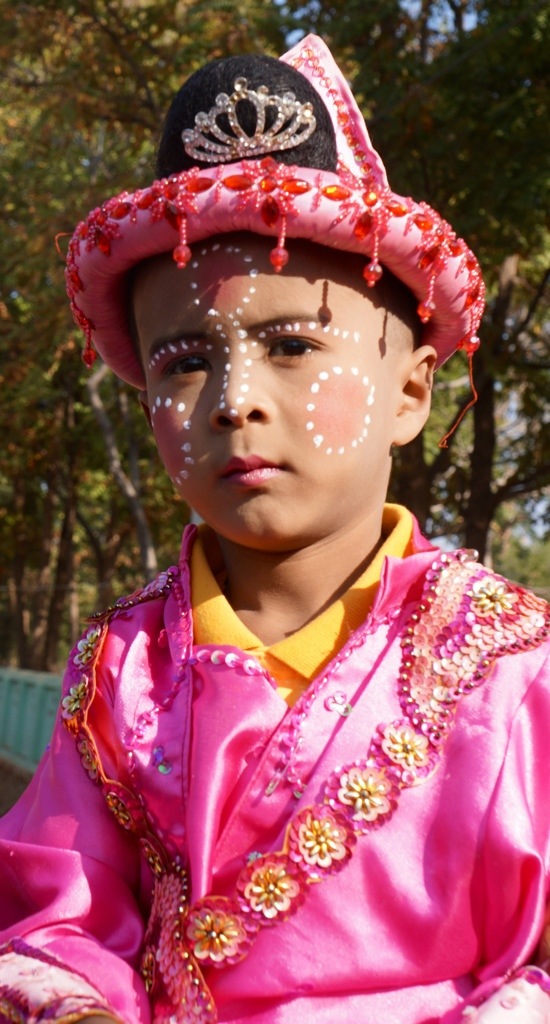
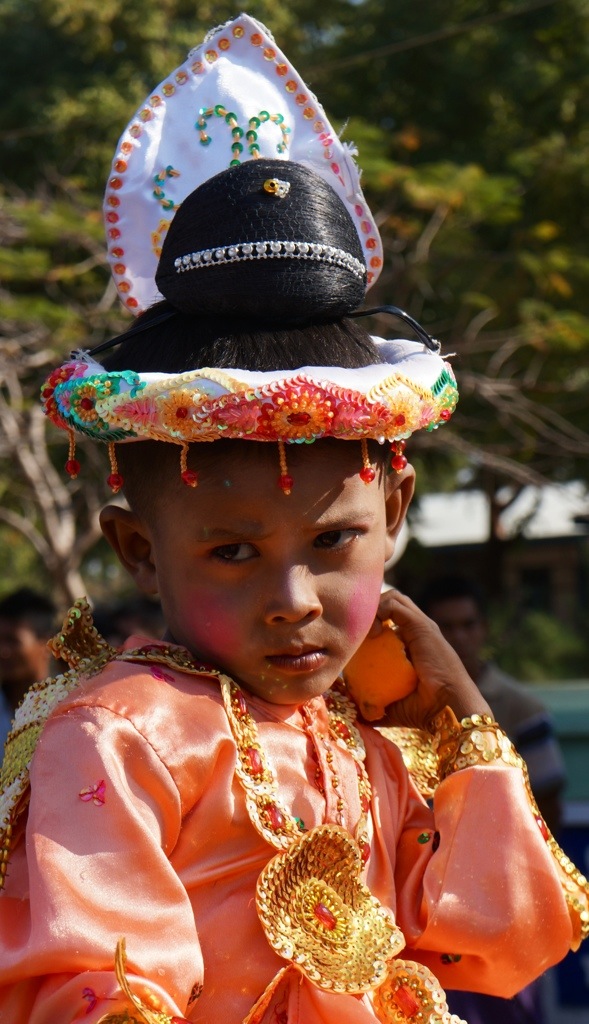
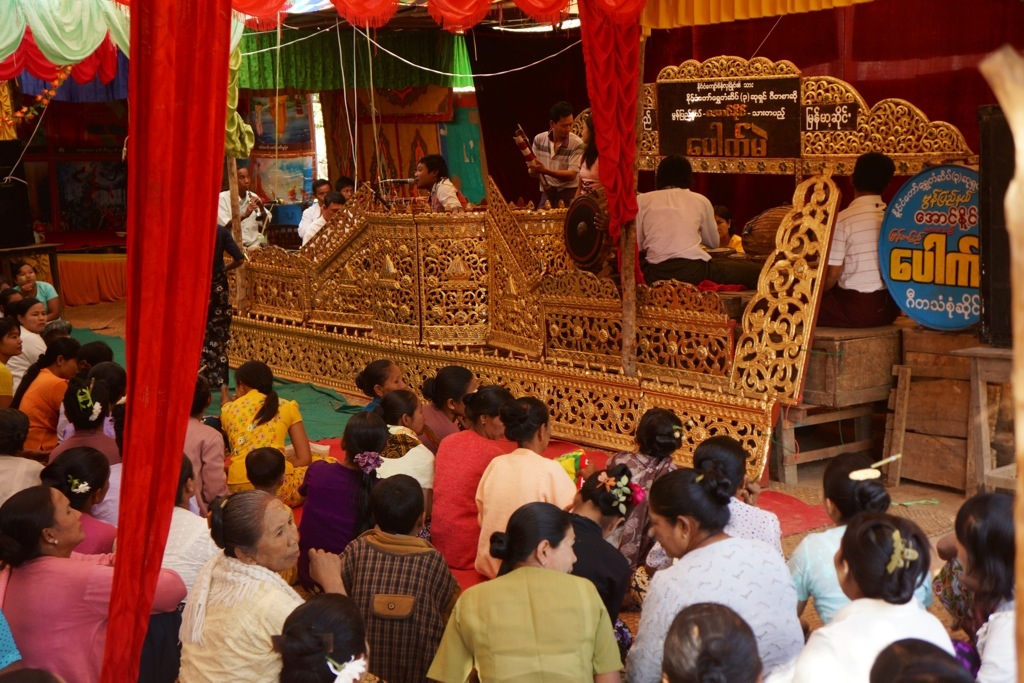
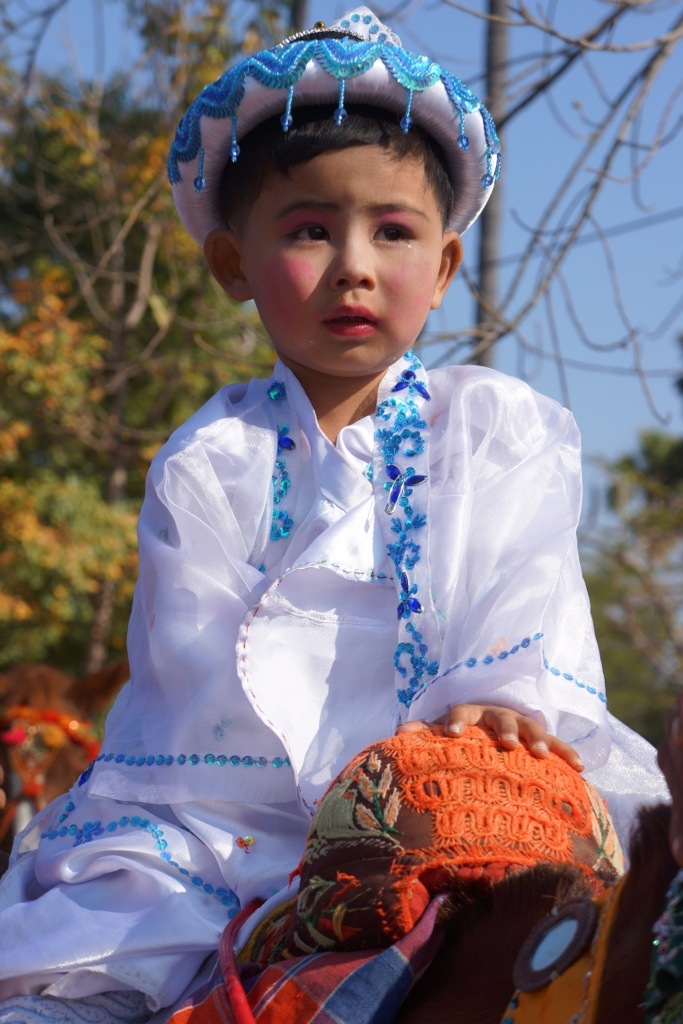
On to Mt. Popa, where we decide to have a go at climbing the stairs to the top, some 777 of them. I think that I can best sum this experience up by saying that 777 is a fuckin’ lotta stairs. Along the way, we see a room with a line of 37 nats, or spirits. Before Buddhism, people believed that these spirits controlled their lives. Some still believe that, and some Buddhists who do not believe it still pray to the nats, just in case.
We rest a number of times on the way up. Pesky monkeys line the steps and are shooed away by a couple guys yelling and firing stones from sling shots at them. At the top, there’s a pretty view of the surrounding areas, and several shrines the import of which I don’t fully get. The walk down is rather trying as well, and our legs are rubbery.
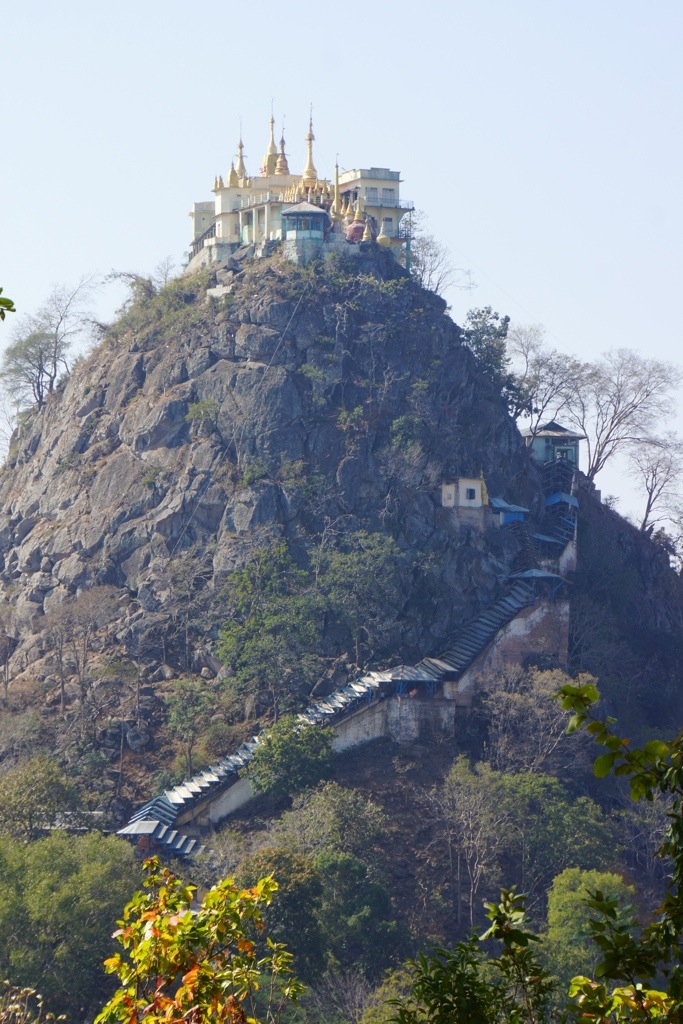
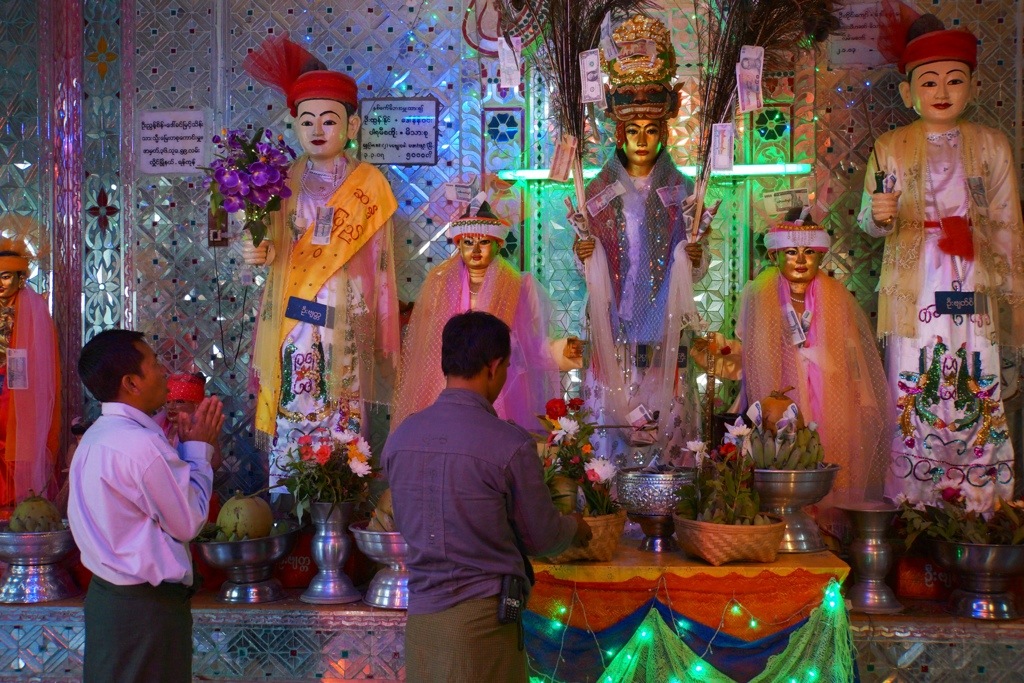
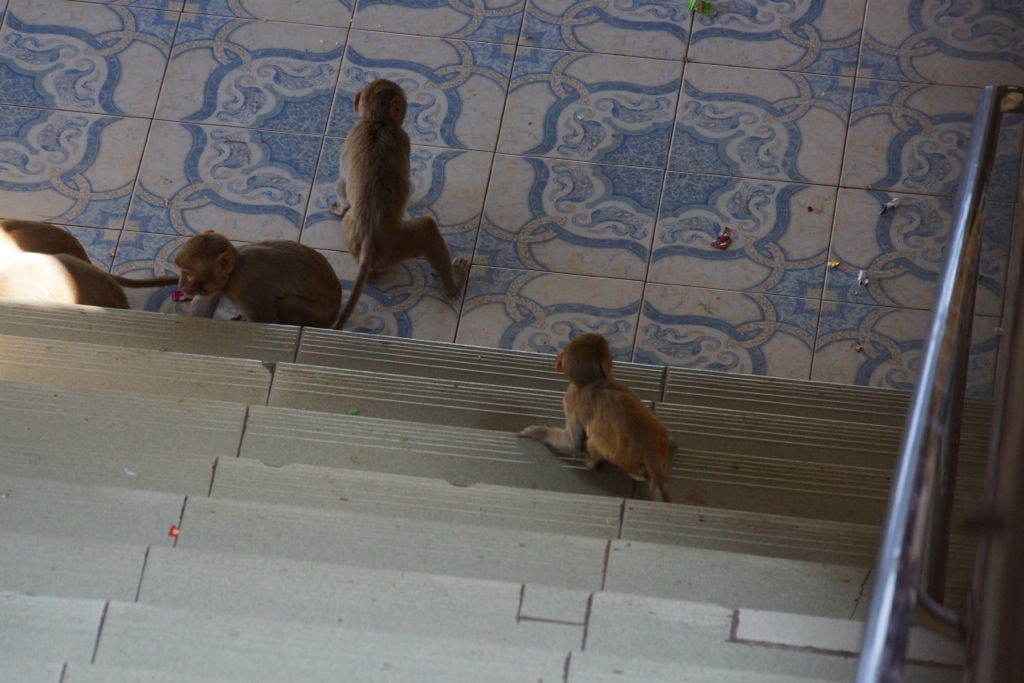
Drive to Mt. Popa Lodge, with a lovely view of Mt. Popa. We encounter Sue and Burt, from New Jersey, who we’d seen on our balloon trip, and have a nice chat with them. They are winding up a 37-day trip to Vietnam, Cambodia, Thailand and Myanmar, and head home tomorrow. They love architecture and have taken all of the architectural tours in Chicago.
We drive to a place that does lacquerware, something that Myanmar is noted for. The owner of the place explains the amazing process in great detail, and we now have a very healthy appreciation for that art. Takes months to execute a piece, and we saw work in various stages of progress. Did not buy anything, though if we’d had room for some wonderful large screens, we’d have been very tempted to splurge.
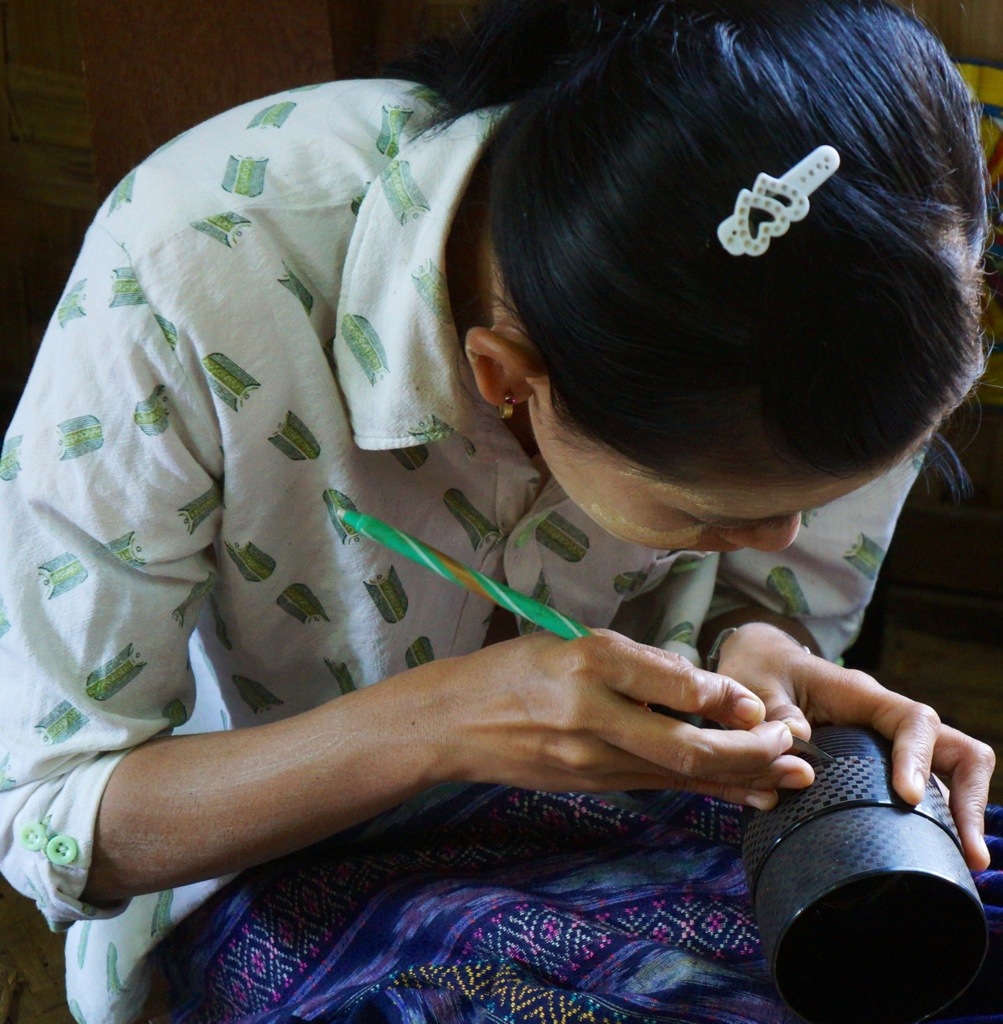
Returned to see the month-long festival, and this time avoided the Crap R Us area. What we really were interested in seeing, though, were the tented encampments inhabited by people who had come by ox-cart, bicycle and other means to spend a month selling their produce and celebrating the festival. Behind the tents, one can see the magnificent pagodas. We steered Dee Dee in that direction and, pushing her to introduce us to folks, were warmly welcomed into four different tents, and offered peanuts and other things. Our greatest success was when we said, “mingalaba,” which means hello (and which I mispronounced “mandalaba”). This evoked smiles and laughter, and made them happy to have their pictures taken.
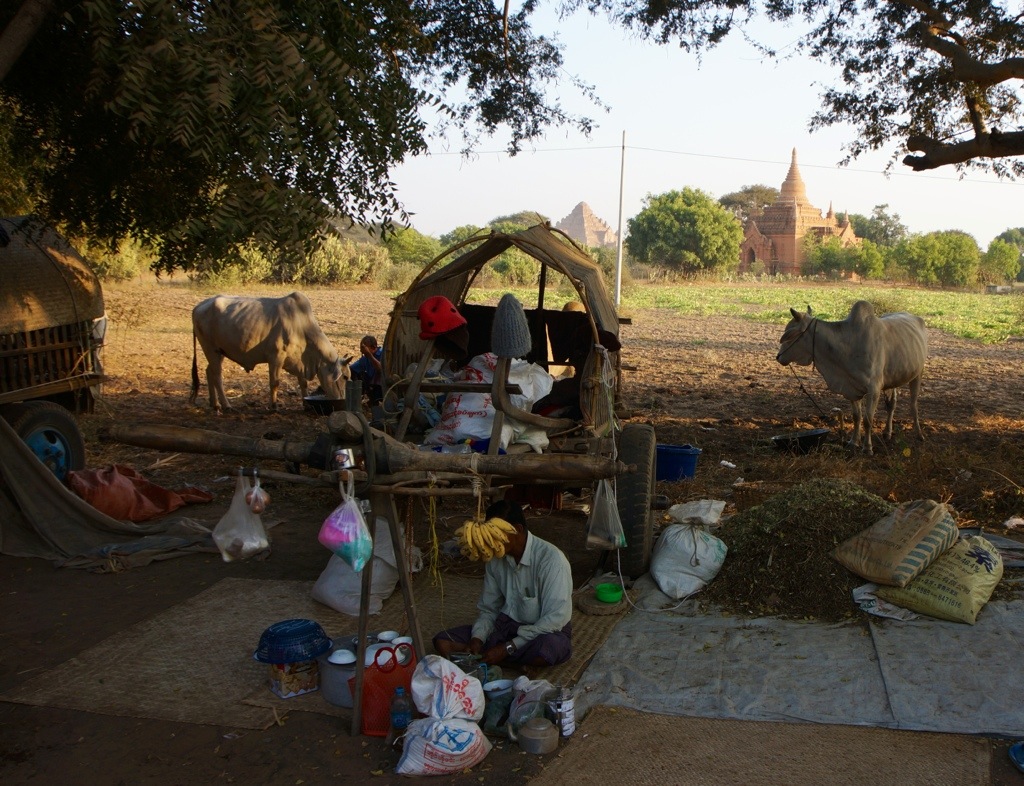
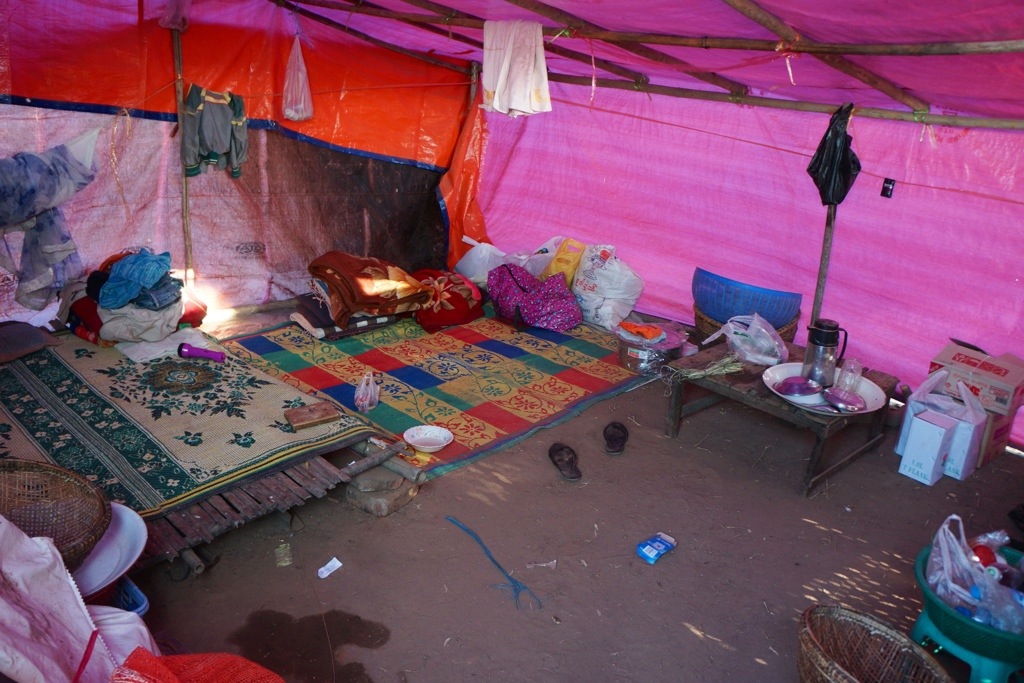
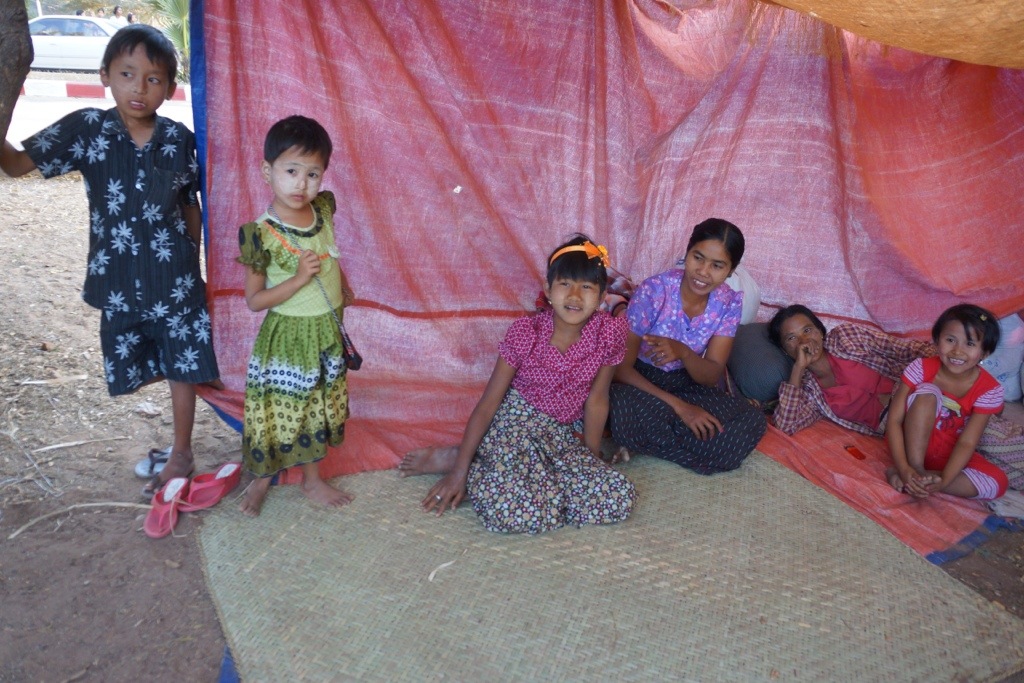
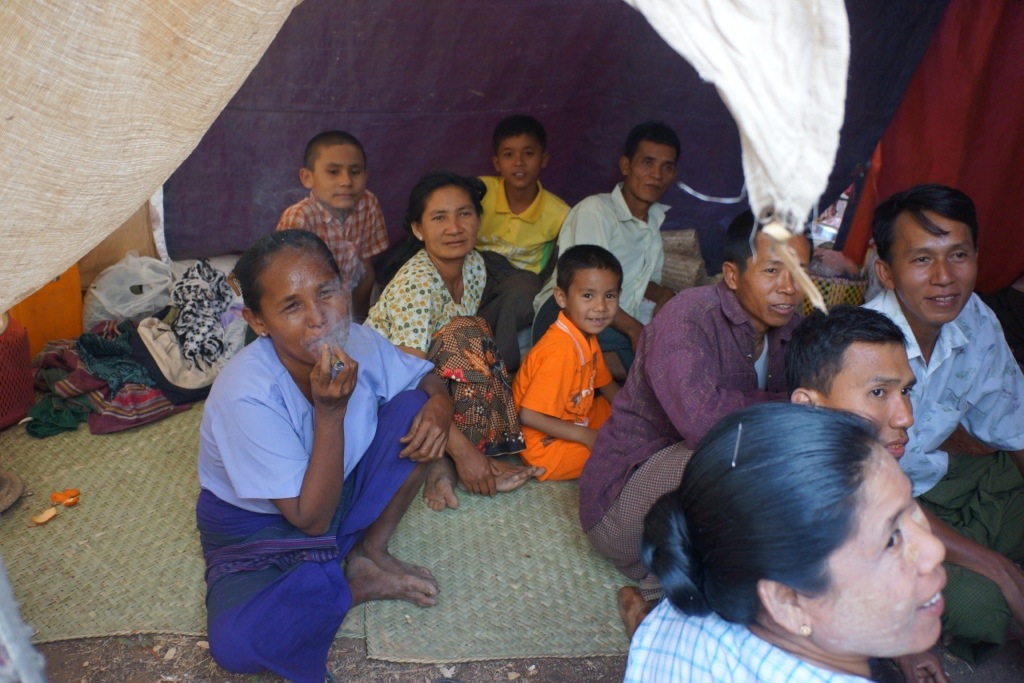
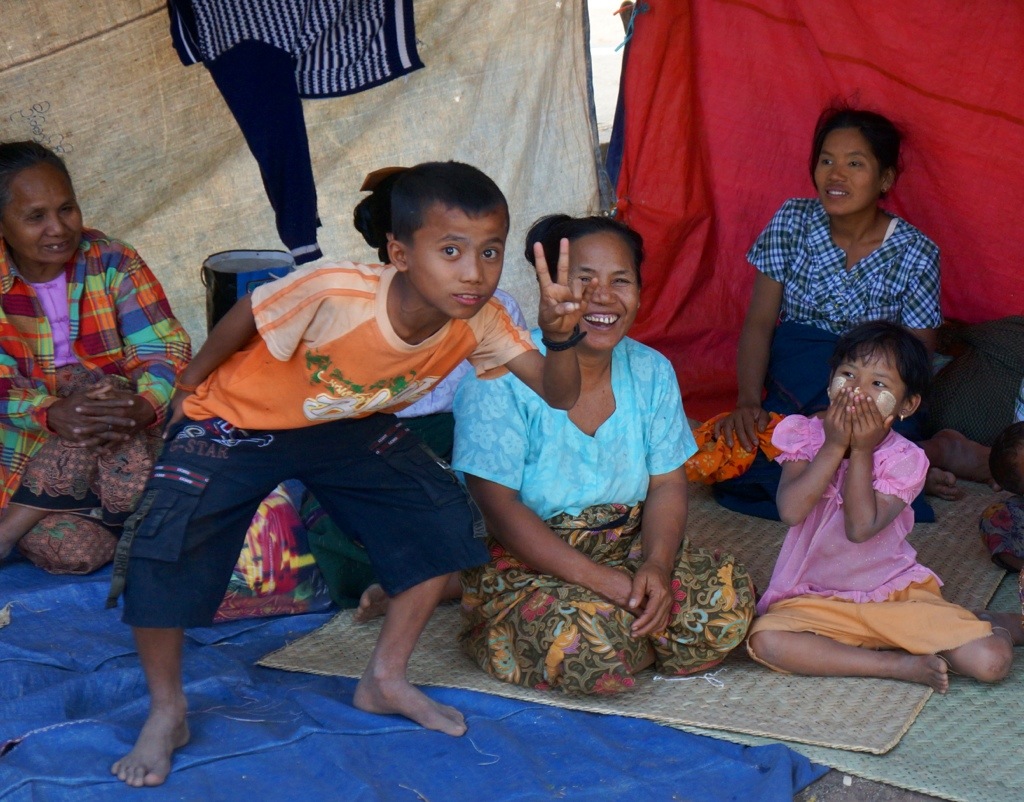

Driven back to the hotel, where we cleaned up, blogged, etc, before dinner at the hotel, which was quite good, especially the spring rolls and the apple crumble a la mode, both of which Carol and I shared. Watched a puppet show at the restaurant, then read/blogged in the lobby, before going for the 9:30 massages that Carol had booked for us. They were great, and very cheap at $25, each for an hour.
|
|


























































